-
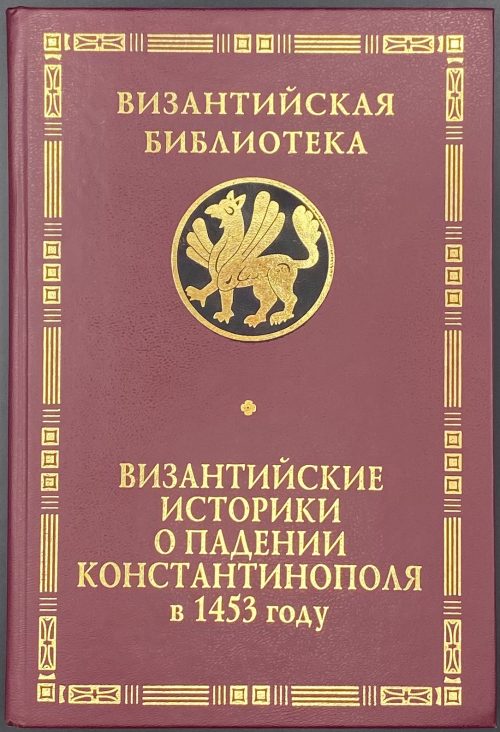 Title: К 550-летию великой трагедии | ВИЗАНТИЙСКИЕ | ИСТОРИКИ | О ПАДЕНИИ | КОНСТАНТИНОПОЛЯ | в 1453 году | Под редакцией | Я. Н. Любарского, | Т. И. Соболь | Санкт-Петербург | АЛЕТЕЙЯ | 2006 || Series: Византийская библиотека. Источники. Pagination: [1-5] 6-189 [3]. Binding: 21.5 x 15 cm; hardcover, crimson buckram, gilt lettering in the border, gilt serial device on black, map endpapers. Print run: 1,000 copies. ISBN: 5-89329-766-0. Michael Critobulus [Μιχαήλ Κριτόβουλος; Михаил Критовул] (Greek, c. 1410 – c. 1470). Doukas [Dukas; Дука; Δούκας] (Greek, c. 1400 – after 1462). Laonikos Chalkokondyles [Laonicus Chalcocondyles; Λαόνικος Χαλκοκονδύλης; Лаоник Халкокондил] (Greek, c. 1430 – c. 1470). Любарский, Яков Николаевич (Russian, 1929 – 2003).
Title: К 550-летию великой трагедии | ВИЗАНТИЙСКИЕ | ИСТОРИКИ | О ПАДЕНИИ | КОНСТАНТИНОПОЛЯ | в 1453 году | Под редакцией | Я. Н. Любарского, | Т. И. Соболь | Санкт-Петербург | АЛЕТЕЙЯ | 2006 || Series: Византийская библиотека. Источники. Pagination: [1-5] 6-189 [3]. Binding: 21.5 x 15 cm; hardcover, crimson buckram, gilt lettering in the border, gilt serial device on black, map endpapers. Print run: 1,000 copies. ISBN: 5-89329-766-0. Michael Critobulus [Μιχαήλ Κριτόβουλος; Михаил Критовул] (Greek, c. 1410 – c. 1470). Doukas [Dukas; Дука; Δούκας] (Greek, c. 1400 – after 1462). Laonikos Chalkokondyles [Laonicus Chalcocondyles; Λαόνικος Χαλκοκονδύλης; Лаоник Халкокондил] (Greek, c. 1430 – c. 1470). Любарский, Яков Николаевич (Russian, 1929 – 2003). -
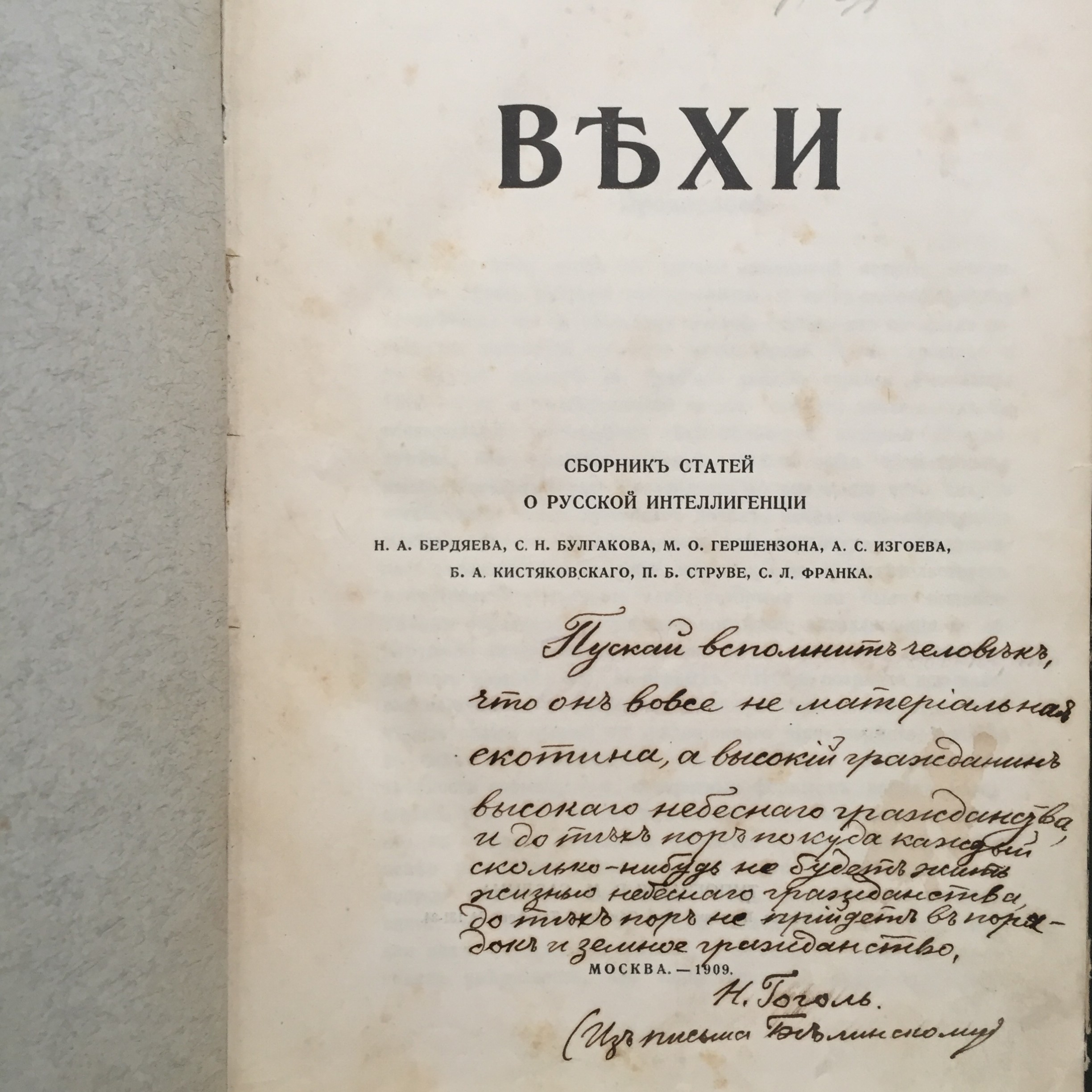
Вехи. Сборник статей о русской интеллигенции. Москва, 1909. Типография В. М. Саблина.
Предисловие. М. О. Гершензон. Н. А. Бердяев. Философская истина и интеллигентская правда. С. Н. Булгаков. Героизм и подвижничество. М. О. Гершензон. Творческое самосознание. Б. А. Кистяковский. В защиту права. П. Б. Струве. Интеллигенция и революция. С. Л. Франк. Этика нигилизма. А. С. Изгоев. Об интеллигентной молодежи. -
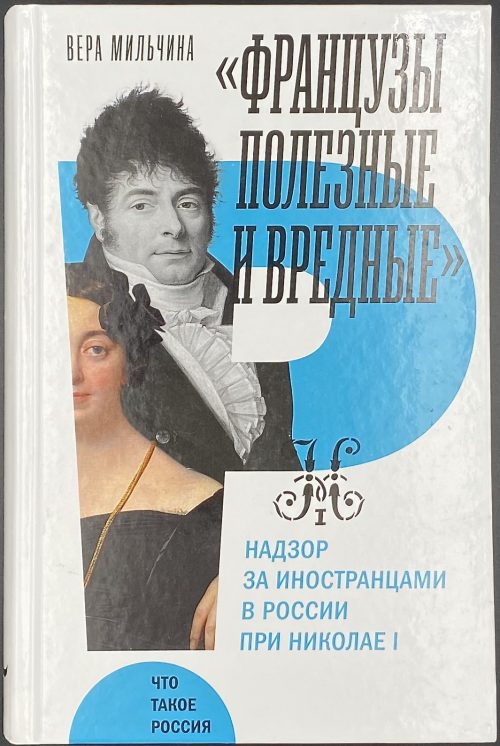 Description: One volume, 20.6 x 13.7 cm, pictorial glossy paper boards; pp.: [1-6] 7-480 [481] [7 advert.]; total 488 pages, ils. ISBN: 978-5-4448-0627-2. Contributor: Вера Аркадьевна Мильчина [Vera Miltchina] (Russian, b. 1953)
Description: One volume, 20.6 x 13.7 cm, pictorial glossy paper boards; pp.: [1-6] 7-480 [481] [7 advert.]; total 488 pages, ils. ISBN: 978-5-4448-0627-2. Contributor: Вера Аркадьевна Мильчина [Vera Miltchina] (Russian, b. 1953) -
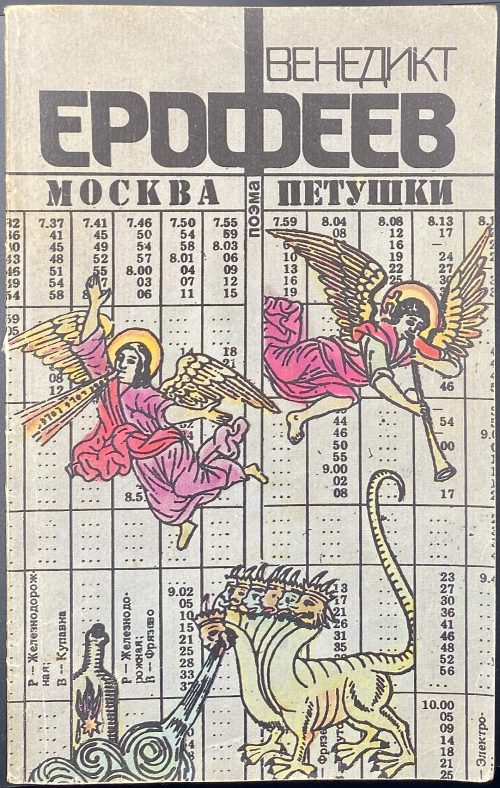 Paperback, 20 x 12.5 cm, grey pictorial wrappers, lettering to front, back, and spine; pp.: [1-2] 3-127 [128]. Title-page: ВЕНЕДИКТ | EРОФЕЕВ | in grid: МОСКВА Р/6520 6308 6494 | {text in grid} | ПЕТУШКИ {publisher’s device} МОСКВА / «ИНТЕРБУК» / 1990 || Print-run: 250,000. Contributors: Венедикт Васильевич Ерофеев [Venedikt Yerofeyev] (Russian, 1938 – 1990) – author.
Paperback, 20 x 12.5 cm, grey pictorial wrappers, lettering to front, back, and spine; pp.: [1-2] 3-127 [128]. Title-page: ВЕНЕДИКТ | EРОФЕЕВ | in grid: МОСКВА Р/6520 6308 6494 | {text in grid} | ПЕТУШКИ {publisher’s device} МОСКВА / «ИНТЕРБУК» / 1990 || Print-run: 250,000. Contributors: Венедикт Васильевич Ерофеев [Venedikt Yerofeyev] (Russian, 1938 – 1990) – author. -
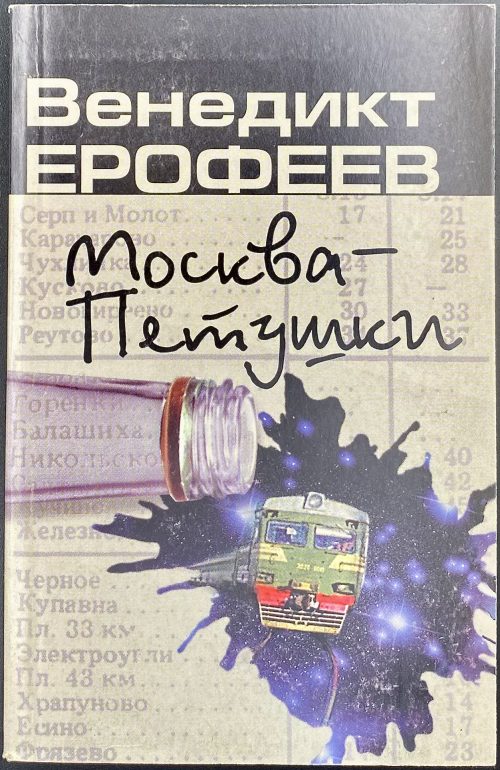 Paperback, 16.5 x 10.8 cm, pictorial wrappers, lettering to front and spine; pp.: [1-4] 5-187 [188] [4]. Title-page: Венедикт | ЕРОФЕЕВ | Москва – | Петушки | ПОЭМА | ВАГРИУС • МОСКВА • 2003 || Print-run: 11,000. Contributors: Венедикт Васильевич Ерофеев [Venedikt Yerofeyev] (Russian, 1938 – 1990) – author. Вагриус – publisher.
Paperback, 16.5 x 10.8 cm, pictorial wrappers, lettering to front and spine; pp.: [1-4] 5-187 [188] [4]. Title-page: Венедикт | ЕРОФЕЕВ | Москва – | Петушки | ПОЭМА | ВАГРИУС • МОСКВА • 2003 || Print-run: 11,000. Contributors: Венедикт Васильевич Ерофеев [Venedikt Yerofeyev] (Russian, 1938 – 1990) – author. Вагриус – publisher. -
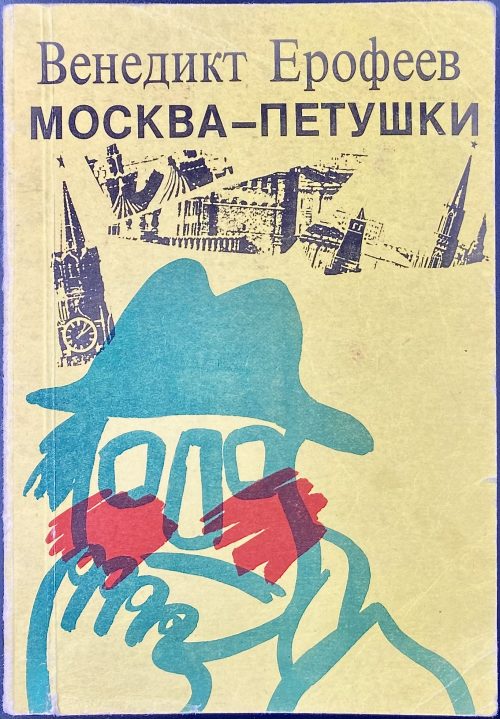 Paperback, 17.2 x 12 cm, yellow pictorial wrappers, lettering to front, back, and spine; pp.: [1-4] 5-137 [5]. Title-page: ВЕНЕДИКТ | ЕРОФЕЕВ | МОСКВА — ПЕТУШКИ | ПОВЕСТЬ | Таллинн | “Александра” | 1990 || Print-run: 30,000. Contributors: Венедикт Васильевич Ерофеев [Venedikt Yerofeyev] (Russian, 1938 – 1990) – author.
Paperback, 17.2 x 12 cm, yellow pictorial wrappers, lettering to front, back, and spine; pp.: [1-4] 5-137 [5]. Title-page: ВЕНЕДИКТ | ЕРОФЕЕВ | МОСКВА — ПЕТУШКИ | ПОВЕСТЬ | Таллинн | “Александра” | 1990 || Print-run: 30,000. Contributors: Венедикт Васильевич Ерофеев [Venedikt Yerofeyev] (Russian, 1938 – 1990) – author. -
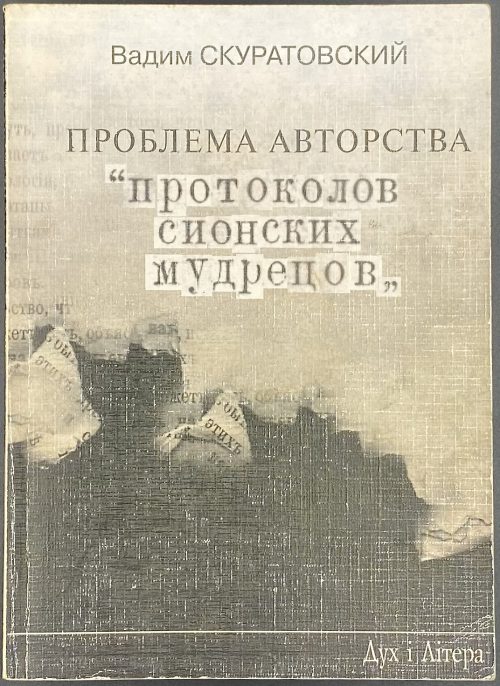 Cover: Вадим Скуратовский | ПРОБЛЕМА АВТОРСТВА | "ПРОТОКОЛОВ | СИОНСКИХ МУДРЕЦОВ" | Дух і літера || Title page: Logo in the upper-left corner: «Ю» БIБЛIОТЕКА | IНСТИТУТУ | ЮДАЇКИ | text in the middle: Вадим Скуратовский | ПРОБЛЕМА АВТОРСТВА | "ПРОТОКОЛОВ | СИОНСКИХ МУДРЕЦОВ" | Киев | 2001 || Pagination: [1-3] 4-241 [242 advert.] Text in Russian. Ukrainian title: Вадим Скуратiвський. Проблема авторства "Протоколiв сiонських старшин" // Київ: "Дух і літера", 2001.
Cover: Вадим Скуратовский | ПРОБЛЕМА АВТОРСТВА | "ПРОТОКОЛОВ | СИОНСКИХ МУДРЕЦОВ" | Дух і літера || Title page: Logo in the upper-left corner: «Ю» БIБЛIОТЕКА | IНСТИТУТУ | ЮДАЇКИ | text in the middle: Вадим Скуратовский | ПРОБЛЕМА АВТОРСТВА | "ПРОТОКОЛОВ | СИОНСКИХ МУДРЕЦОВ" | Киев | 2001 || Pagination: [1-3] 4-241 [242 advert.] Text in Russian. Ukrainian title: Вадим Скуратiвський. Проблема авторства "Протоколiв сiонських старшин" // Київ: "Дух і літера", 2001. -
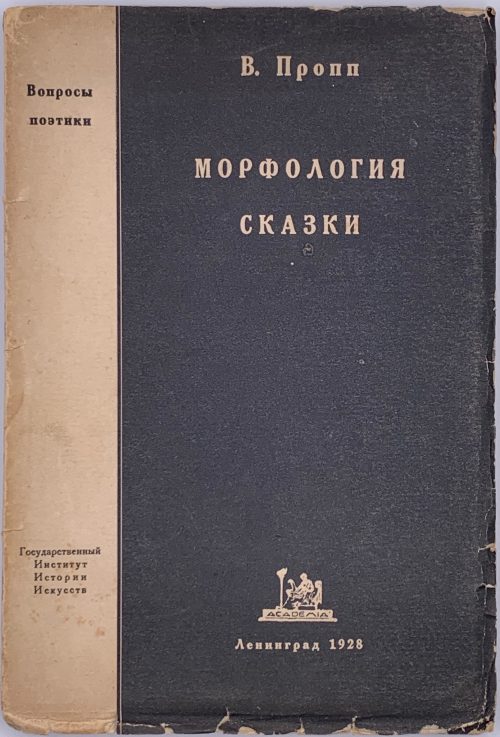 Paperback, 21.3 x 14.5 cm, publisher’s grey and black wrappers with black and grey lettering, respectively; pp. [1-4] 5-151 [1], 152 pages total; collated 8vo: 1-98 104, 76 leaves total. Title-page: В. ПРОПП | МОРФОЛОГИЯ СКАЗКИ | «ACADEMIA» | ЛЕНИНГРАД | 1928 || Frontispiece: ГОСУДАРСТВЕННЫЙ ИНСТИТУТ ИСТОРИИ ИСКУССТВ | ВОПРОСЫ ПОЭТИКИ | НЕПЕРИОДИЧЕСКАЯ СЕРИЯ, ИЗДАВАЕМАЯ | ОТДЕЛОМ СЛОВЕСНЫХ ИСКУССТВ | ВЫПУСК XII | «ACADEMIA» | ЛЕНИНГРАД | 1928 || English title: [LIB-1615.2018] V. Propp. Morphology of the Folktale. — Austin: University of Texas Press, 1979. Print run: 1,600 copies. Catalogue raisonné: Крылов-Кичатова № 328, p. 199. Contributors: Владимир Яковлевич Пропп [Vladimir Propp] (Russian, 1895 – 1970) See also [LIB-1710.2019] (circulation copy) В. Я. Пропп. Исторические корни волшебной сказки (2-е изд.) — Л.: Изд-во ЛГУ, 1986 and (first edition) [LIB-3184.2023] В. Я. Пропп. Исторические корни волшебной сказки. — Л.: Изд-во Ленинградского ун-та, 1946.
Paperback, 21.3 x 14.5 cm, publisher’s grey and black wrappers with black and grey lettering, respectively; pp. [1-4] 5-151 [1], 152 pages total; collated 8vo: 1-98 104, 76 leaves total. Title-page: В. ПРОПП | МОРФОЛОГИЯ СКАЗКИ | «ACADEMIA» | ЛЕНИНГРАД | 1928 || Frontispiece: ГОСУДАРСТВЕННЫЙ ИНСТИТУТ ИСТОРИИ ИСКУССТВ | ВОПРОСЫ ПОЭТИКИ | НЕПЕРИОДИЧЕСКАЯ СЕРИЯ, ИЗДАВАЕМАЯ | ОТДЕЛОМ СЛОВЕСНЫХ ИСКУССТВ | ВЫПУСК XII | «ACADEMIA» | ЛЕНИНГРАД | 1928 || English title: [LIB-1615.2018] V. Propp. Morphology of the Folktale. — Austin: University of Texas Press, 1979. Print run: 1,600 copies. Catalogue raisonné: Крылов-Кичатова № 328, p. 199. Contributors: Владимир Яковлевич Пропп [Vladimir Propp] (Russian, 1895 – 1970) See also [LIB-1710.2019] (circulation copy) В. Я. Пропп. Исторические корни волшебной сказки (2-е изд.) — Л.: Изд-во ЛГУ, 1986 and (first edition) [LIB-3184.2023] В. Я. Пропп. Исторические корни волшебной сказки. — Л.: Изд-во Ленинградского ун-та, 1946. -
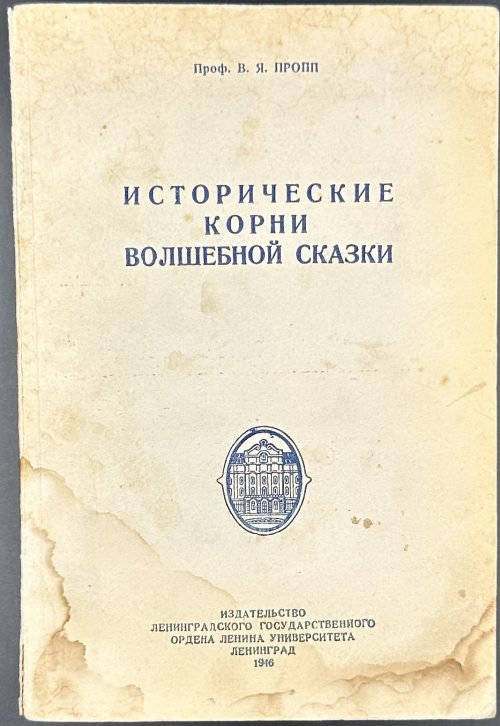 Paperback, 21.3 x 14.4 cm, 8vo, in original wrappers, lettered to front and spine, printed on brownish paper, previous owner's blue crayon manuscript, water stain to the outside, collated [1] 2-208 2110 (total 340 pp.); pp: [1-5] 6-340. Title-page: Пооф. В. Я. ПРОПП | ИСТОРИЧЕСКИЕ | КОРНИ | ВОЛШЕБНОЙ СКАЗКИ | ИЗДАТЕЛЬСТВО | ЛЕНИНГРАДСКОГО ГОСУДАРСТВЕННОГО | ОРДЕНА ЛЕНИНА УНИВЕРСИТЕТА | ЛЕНИНГРАД | 1946 || Print run: 10,000 copies. Contributors: Владимир Яковлевич Пропп [Vladimir Propp] (Russian, 1895 – 1970) For the circulation copy see [LIB-1710.2019] В. Я. Пропп. Исторические корни волшебной сказки (2-е изд.) — Л.: Изд-во ЛГУ, 1986. English title: [LIB-1615.2018] V. Propp. Morphology of the Folktale. — Austin: University of Texas Press, 1979.
Paperback, 21.3 x 14.4 cm, 8vo, in original wrappers, lettered to front and spine, printed on brownish paper, previous owner's blue crayon manuscript, water stain to the outside, collated [1] 2-208 2110 (total 340 pp.); pp: [1-5] 6-340. Title-page: Пооф. В. Я. ПРОПП | ИСТОРИЧЕСКИЕ | КОРНИ | ВОЛШЕБНОЙ СКАЗКИ | ИЗДАТЕЛЬСТВО | ЛЕНИНГРАДСКОГО ГОСУДАРСТВЕННОГО | ОРДЕНА ЛЕНИНА УНИВЕРСИТЕТА | ЛЕНИНГРАД | 1946 || Print run: 10,000 copies. Contributors: Владимир Яковлевич Пропп [Vladimir Propp] (Russian, 1895 – 1970) For the circulation copy see [LIB-1710.2019] В. Я. Пропп. Исторические корни волшебной сказки (2-е изд.) — Л.: Изд-во ЛГУ, 1986. English title: [LIB-1615.2018] V. Propp. Morphology of the Folktale. — Austin: University of Texas Press, 1979. -
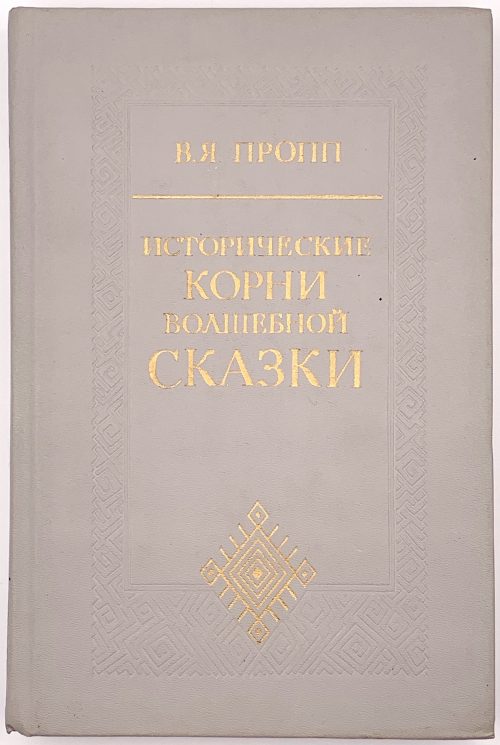 Hardcover volume, 22.2 x 14.8 cm, bound in grey buckram, gilt lettering in an ornamental frame to front and spine, blind-stamped lettering to back; pp.: [1-2] 3-364 [4], collated 8vo:1-238, total 184 leaves, 368 pages. Title-page: ЛЕНИНГАДСКИЙ ОРДЕНА ЛЕНИНА | И ОРДЕНА ТРУДОВОГО КРАСНОГО ЗНАМЕНИ | ГОСУДАРСТВЕННЫЙ УНИВЕРСИТЕТ ИМЕНИ А. А. ЖДАНОВА | {in two-compartment frame: В. Я. ПРОПП {within a compartment} | ИСТОРИЧЕСКИЕ КОРНИ ВОЛШЕБНОЙ СКАЗКИ {within a compartment} | ИЗДАТЕЛЬСТВО ЛЕНИНГРАДСКОГО УНИВЕРСИТЕТА | ЛЕНИНГРАД 1986 || Print run: 25,000 copies. Edition: 2nd edition; for the 1st edition, see [LIB-3184.2023] В. Я. Пропп. Исторические корни волшебной сказки. — Л.: ЛГУ, 1946. English title: [LIB-1615.2018] The historical roots of the fairy tale. Contributors: Владимир Яковлевич Пропп [Vladimir Propp] (Russian, 1895 – 1970)
Hardcover volume, 22.2 x 14.8 cm, bound in grey buckram, gilt lettering in an ornamental frame to front and spine, blind-stamped lettering to back; pp.: [1-2] 3-364 [4], collated 8vo:1-238, total 184 leaves, 368 pages. Title-page: ЛЕНИНГАДСКИЙ ОРДЕНА ЛЕНИНА | И ОРДЕНА ТРУДОВОГО КРАСНОГО ЗНАМЕНИ | ГОСУДАРСТВЕННЫЙ УНИВЕРСИТЕТ ИМЕНИ А. А. ЖДАНОВА | {in two-compartment frame: В. Я. ПРОПП {within a compartment} | ИСТОРИЧЕСКИЕ КОРНИ ВОЛШЕБНОЙ СКАЗКИ {within a compartment} | ИЗДАТЕЛЬСТВО ЛЕНИНГРАДСКОГО УНИВЕРСИТЕТА | ЛЕНИНГРАД 1986 || Print run: 25,000 copies. Edition: 2nd edition; for the 1st edition, see [LIB-3184.2023] В. Я. Пропп. Исторические корни волшебной сказки. — Л.: ЛГУ, 1946. English title: [LIB-1615.2018] The historical roots of the fairy tale. Contributors: Владимир Яковлевич Пропп [Vladimir Propp] (Russian, 1895 – 1970) -
![Адарюковъ В.Я. Добавленiя и исправленiя къ подробномусловарю русскихъ гравированныхъ портретовъ Д.А.Ровинскаго, СПб. 1889. — Издание журнала "Старые годы", 1911. — 89 стр. [Владимир Яковлевич Адарюков (1863 -1932). Добавления и исправления к подробному словарю русских гравированных портретов Д.А.Ровинскаго].](https://varshavskycollection.com/wp-content/uploads/2021/02/LIB-1612-a-500x739.jpg) Title: В. Я. АДАРЮКОВЪ. | ДОБАВЛЕНIЯ И ИСПРАВЛЕНIЯ КЪ ПОДРОБНОМУ СЛОВАРЮ | РУССКИХЪ | ГРАВИРОВАННЫХЪ ПОРТРЕТОВЪ Д. А. РОВИНСКАГО | СПБ. 1889 г. | ИЗДАНИЕ ЖУРНАЛА «СТАРЫЕ ГОДЫ» | 1911. Pagination: [1-4] – incl. orig. wrappers with engraved vignette, 5-89 [90 blank], illustr. Size: 27 x 18.7 cm. Binding: Hardcover; owner's half brown buckram over cloth, original wrappers bound in. Printed on laid paper. Edition: 1st edition, limited: №91 of 150. Inscription to t.p.: Крамарев, 27.5.39. Errata inserts on p. 29 and 77
Title: В. Я. АДАРЮКОВЪ. | ДОБАВЛЕНIЯ И ИСПРАВЛЕНIЯ КЪ ПОДРОБНОМУ СЛОВАРЮ | РУССКИХЪ | ГРАВИРОВАННЫХЪ ПОРТРЕТОВЪ Д. А. РОВИНСКАГО | СПБ. 1889 г. | ИЗДАНИЕ ЖУРНАЛА «СТАРЫЕ ГОДЫ» | 1911. Pagination: [1-4] – incl. orig. wrappers with engraved vignette, 5-89 [90 blank], illustr. Size: 27 x 18.7 cm. Binding: Hardcover; owner's half brown buckram over cloth, original wrappers bound in. Printed on laid paper. Edition: 1st edition, limited: №91 of 150. Inscription to t.p.: Крамарев, 27.5.39. Errata inserts on p. 29 and 77 -
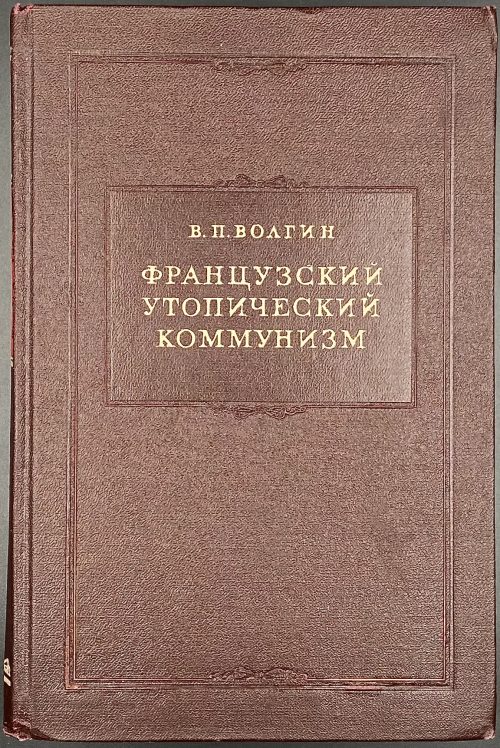 Title page: АКАДЕМИЯ НАУК СССР | В. П. ВОЛГИН. | ФРАНЦУЗСКИЙ | УТОПИЧЕСКИЙ | КОММУНИЗМ | ИЗДАТЕЛЬСТВО АКАДЕМИИ НАУК СССР | МОСКВА 1960 || Pagination: [1-5] 6-375 [376], errata slip. Collation: 8vo; [1]-228, 234, 248 (total 188 leaves) + errata slip; 171 unsigned. Print run: 4200 copies. Binding: Burgundy buckram, lettering in blind-stamped frame: В. П. Волгин. Французский утопический коммунизм. Contributor: Волгин, Вячеслав Петрович (Russian, 1879 – 1962) – author.
Title page: АКАДЕМИЯ НАУК СССР | В. П. ВОЛГИН. | ФРАНЦУЗСКИЙ | УТОПИЧЕСКИЙ | КОММУНИЗМ | ИЗДАТЕЛЬСТВО АКАДЕМИИ НАУК СССР | МОСКВА 1960 || Pagination: [1-5] 6-375 [376], errata slip. Collation: 8vo; [1]-228, 234, 248 (total 188 leaves) + errata slip; 171 unsigned. Print run: 4200 copies. Binding: Burgundy buckram, lettering in blind-stamped frame: В. П. Волгин. Французский утопический коммунизм. Contributor: Волгин, Вячеслав Петрович (Russian, 1879 – 1962) – author. -
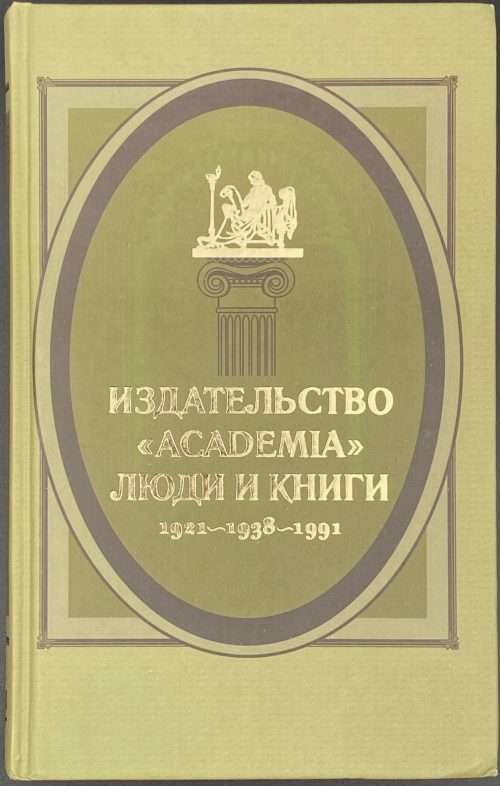 Hardcover, 20.7 x 13 cm, paper boards and spine, silver and gilt lettering, pictorial endpapers, pp.: [1-5] 6-321 [5] [10 advert.], in-text ill., total 336 pages plus 12 (8+4) leaves of plates. 944 entries (1921-1938), plus a list of new books published between 1991 and 2004. Title-page: В. В. Крылов | Е. В. Кичатова | ИЗДАТЕЛЬСТВО | «ACADEMIA» | ЛЮДИ И КНИГИ | 1921 ~ 1938 ~ 1991 | Под общей редакцией | В. А. Попова | ~ | {publisher’s device} | Москва | 2004 || Print run: 2,000 copeis. Contributors: Крылов, Вячеслав Викторович (Russian, 1940 – 2005) Кичатова, Екатерина Вячеславовна (Russian)
Hardcover, 20.7 x 13 cm, paper boards and spine, silver and gilt lettering, pictorial endpapers, pp.: [1-5] 6-321 [5] [10 advert.], in-text ill., total 336 pages plus 12 (8+4) leaves of plates. 944 entries (1921-1938), plus a list of new books published between 1991 and 2004. Title-page: В. В. Крылов | Е. В. Кичатова | ИЗДАТЕЛЬСТВО | «ACADEMIA» | ЛЮДИ И КНИГИ | 1921 ~ 1938 ~ 1991 | Под общей редакцией | В. А. Попова | ~ | {publisher’s device} | Москва | 2004 || Print run: 2,000 copeis. Contributors: Крылов, Вячеслав Викторович (Russian, 1940 – 2005) Кичатова, Екатерина Вячеславовна (Russian)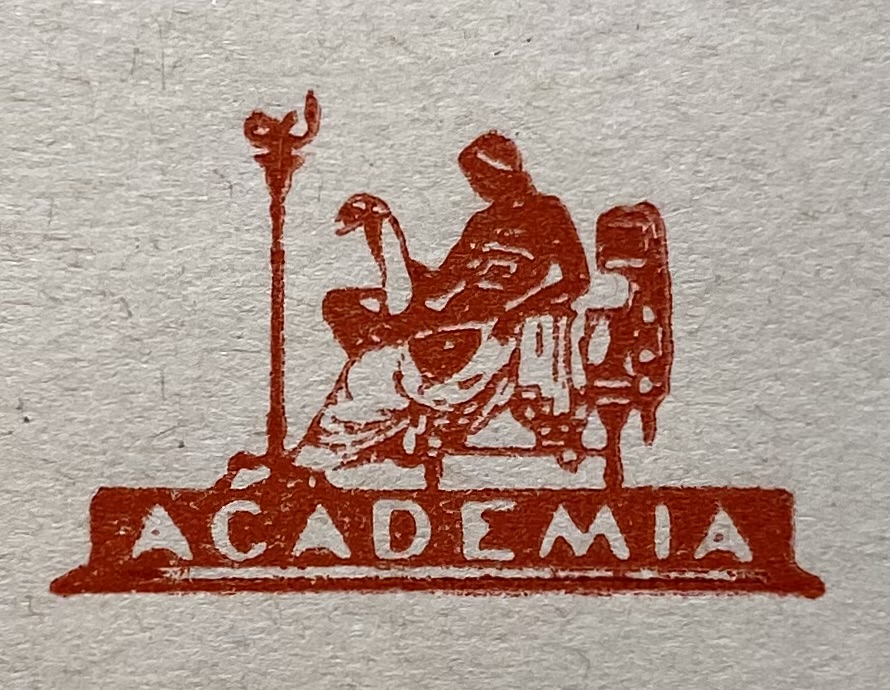
-
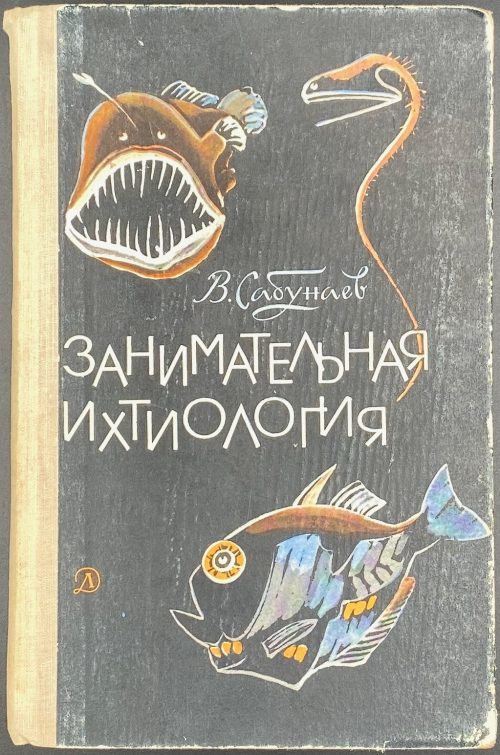 Hardcover, 20.5 x 13.5 cm, quarter cloth, pictorial boards, pp.: [2] 3-253 [3], ils., collated in-8vo: 1-188, total 128 leaves plus 2 leaves of colour plates. Title-page: В. САБУНАЕВ | ЗАНИМАТЕЛЬНАЯ | ИХТИОЛОГИЯ | {vignette} | ИЗДАТЕЛЬСТВО | “ДЕТСКАЯ ЛИТЕРАТУРА” | 1967. Print rub: 50,000 copies. Сабунаев, Виктор Борисович (Russian, 20th century) – author. Бианки, Елена Витальевна (Russian, 1922 – 2009) – artist.
Hardcover, 20.5 x 13.5 cm, quarter cloth, pictorial boards, pp.: [2] 3-253 [3], ils., collated in-8vo: 1-188, total 128 leaves plus 2 leaves of colour plates. Title-page: В. САБУНАЕВ | ЗАНИМАТЕЛЬНАЯ | ИХТИОЛОГИЯ | {vignette} | ИЗДАТЕЛЬСТВО | “ДЕТСКАЯ ЛИТЕРАТУРА” | 1967. Print rub: 50,000 copies. Сабунаев, Виктор Борисович (Russian, 20th century) – author. Бианки, Елена Витальевна (Russian, 1922 – 2009) – artist. -
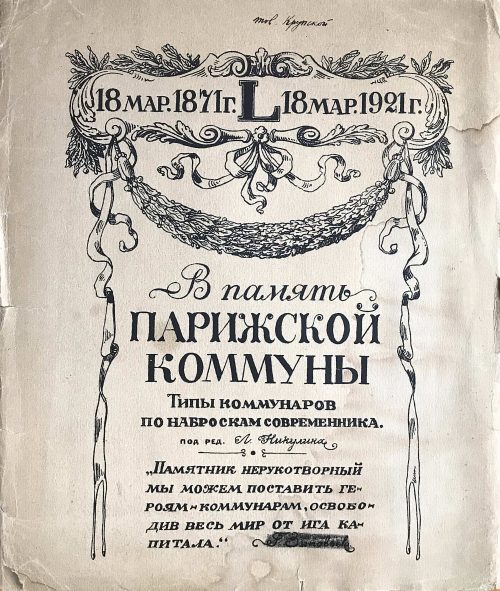
Unbound Quatro (246 x 321 mm) album in softcover with inscription:
В память Парижской коммуны. 18 мар. 1871 - 18 мар. 1921. L. Типы комунаров по наброскам современника. Под ред. Л. Никулина. "Памятник нерукотворный мы можем поставить героям-коммунарам, освободив весь мир от ига капитала." Г. Зиновьев.
Надписано от руки: Экз. тов. Крупской.
17 отпечатков с измененных литографий Берталя (без ссылки). Издание Политотдела Балтийского Флота и Петроградского губ. Отд. народн. Образования. Петроград.
Translation from Russian: In memory of the Paris Commune. March 18, 1871 - March 18, 1921. (L*). Types of the communards from the sketches of contemporaries. Edited by L. Nikulin. "Not-made-by-hand monument we will erect to the heroic Communards by freeing the world from the yoke of capital". G. Zinoviev. Handwritten inscription in black ink: Copy of (or for) comrade Krupskaya. The album consists of 17 unnumbered prints with captions in Russian. The prints are altered images made by Bertall, with no reference to the artist. The album is published by Political division of Baltic Navy and Petrograd district of public education. Printed in Petrograd (Saint Petersburg). *Roman letter L - Fifty (Fifty year anniversary) -
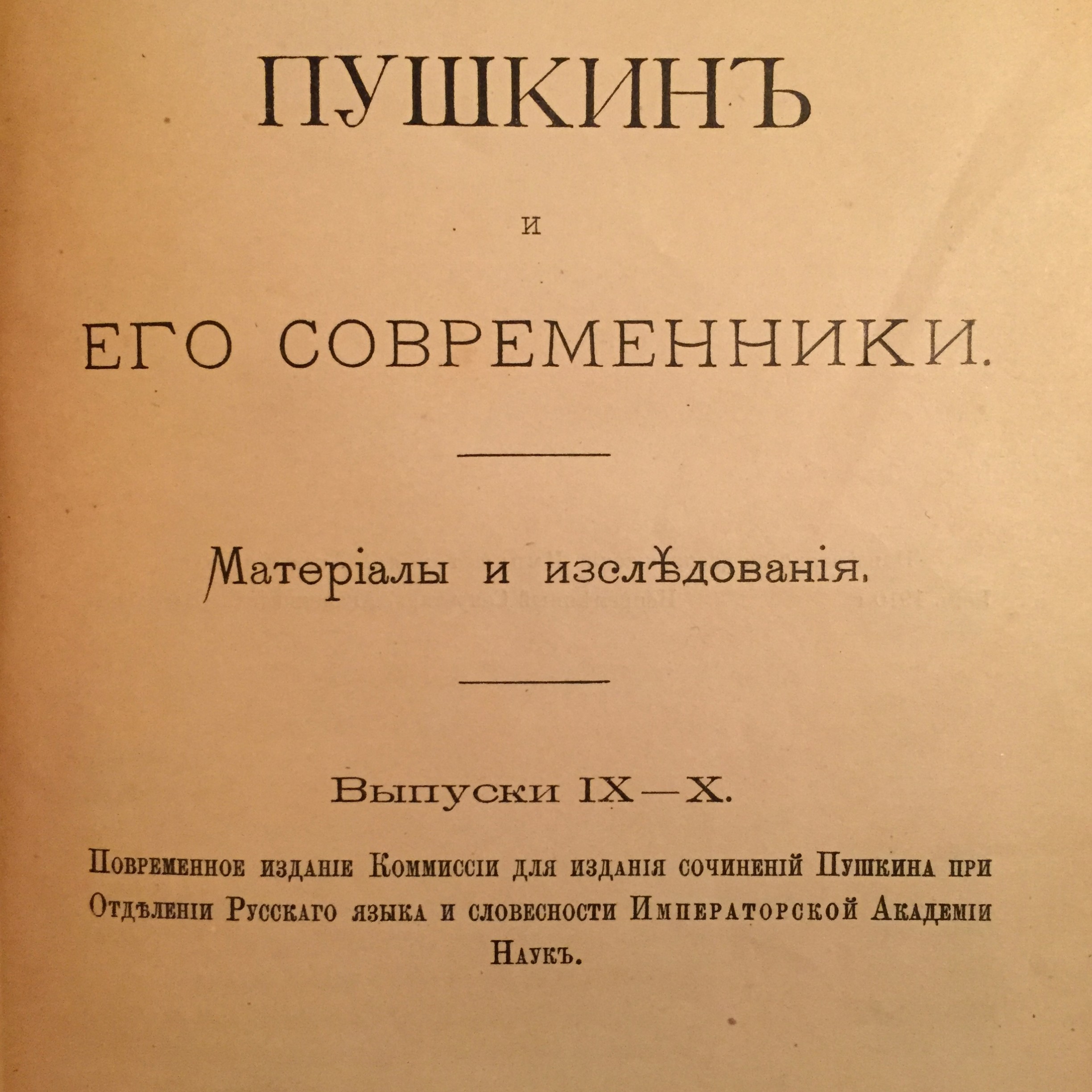
Библиотека А.С.Пушкина. Библиографическое описание.
Пушкин и его современники. Материалы и изследования. Вып. IX- X. Повременное изданiе Коммиссiи для изданiя сочиненiй Пушкина при Отдѣленiи Русскаго языка и словесности Императорской Академiи Наукъ.
СПб.: Тип.Императорской Академiи Наук, 1910. - 461 стр.
-
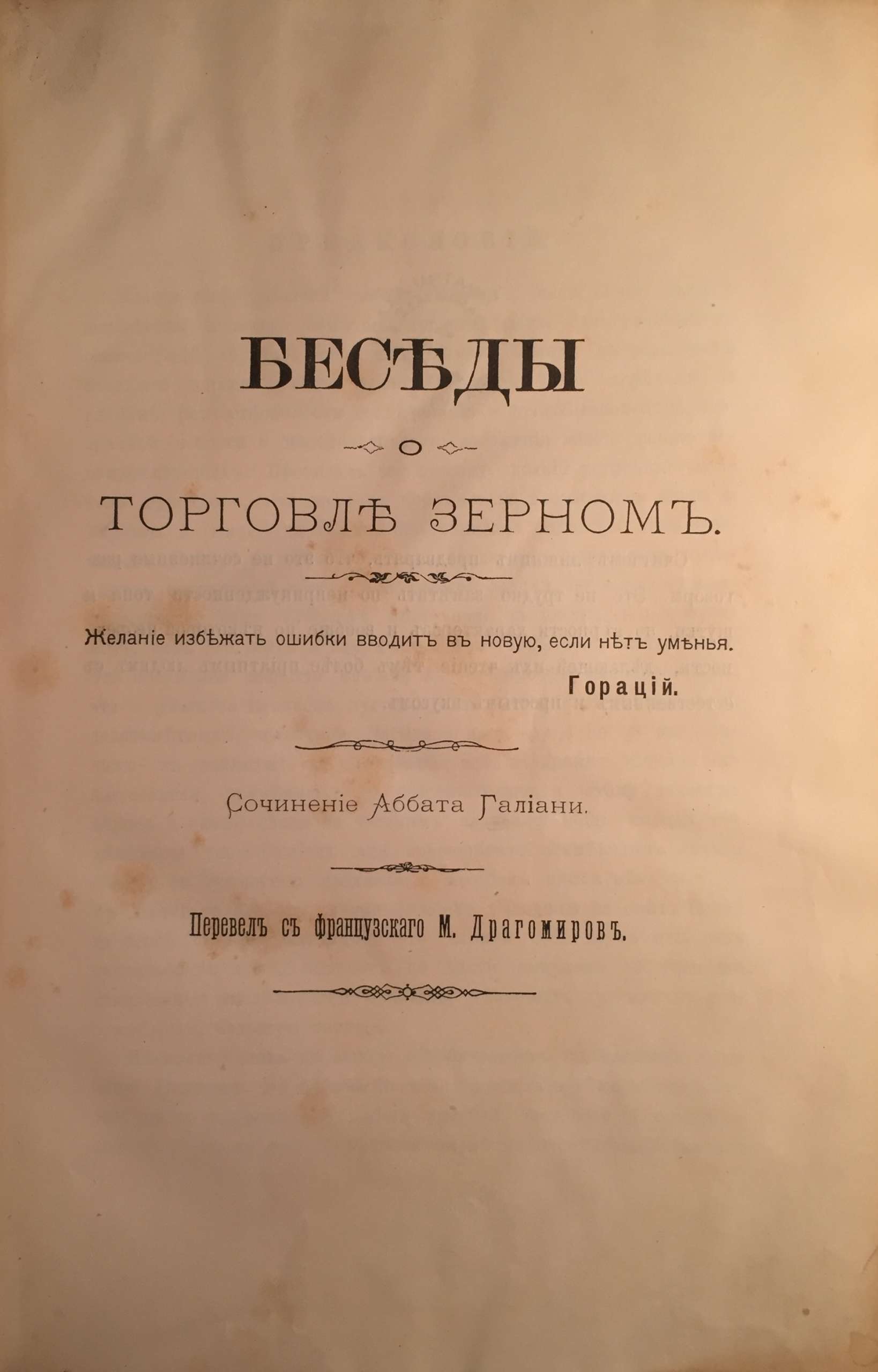
Беседы о торговле зерном. Сочинение аббата Галиани. Перевел с французского М. Драгомиров. — [Киев]: [тип. Окр. Штаба], [1891]. — [4], III, [3], 210, XXII стр. Примечание: Доб. тит. л. на фр. яз.: Dialogues sur le commerce des bleds. — A Londres, MDCCLXX.
-
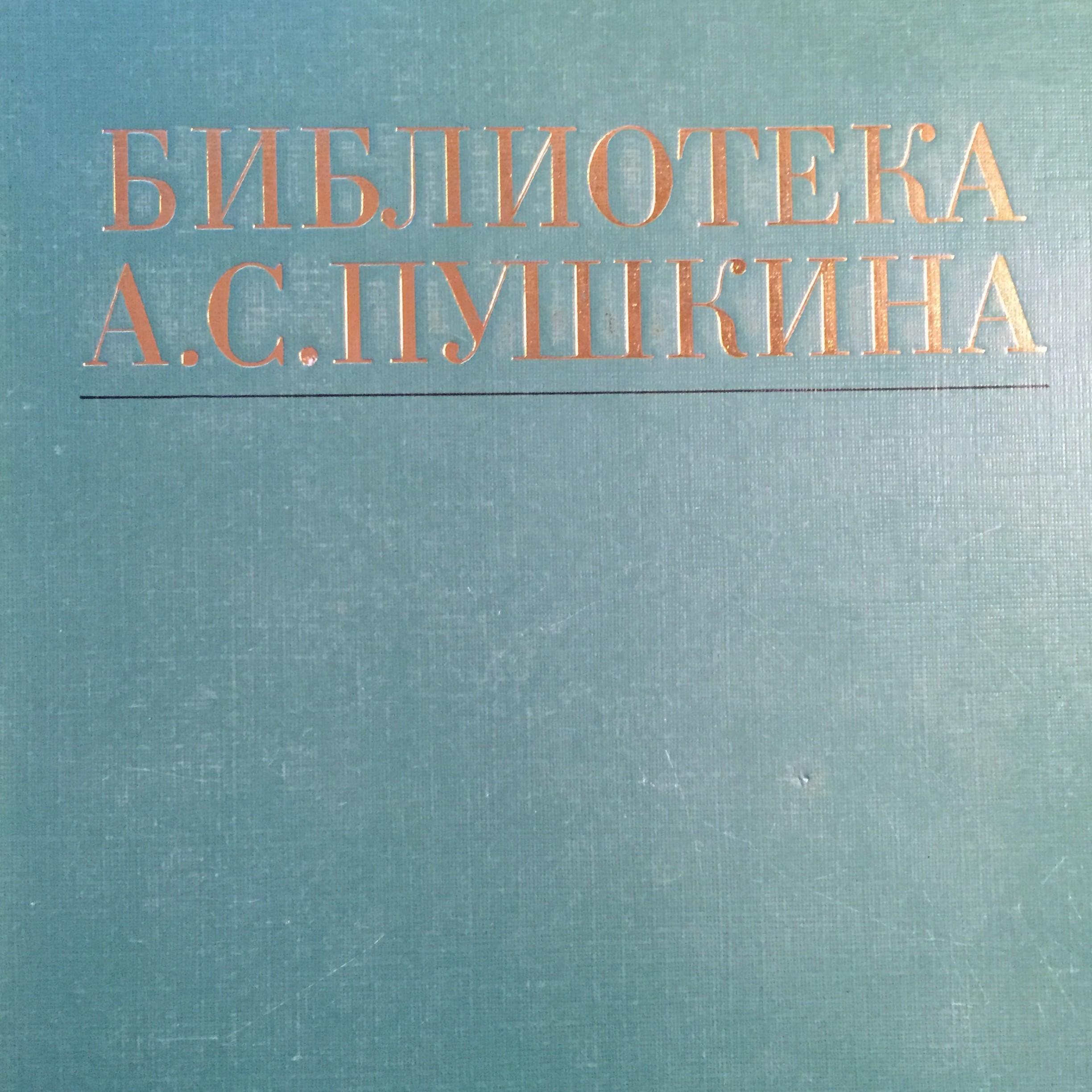
Б. Л. Модзалевский. Библиотека А.С.Пушкина. Библиографическое описание. Отдѣльный оттискъ из изданiя "Пушкинъ и его современники", вып. IX-X. -- СПб.: Тип. Императорской Академiи Наук, 1910. - 442 стр. [РЕПРИНТ 1988 года.]
Библиотека А. С. Пушкина. Б. Л. Модзалевский. Приложение к репринтному изданию. -- М.: Книга, 1988. - 115 стр. Тираж 10 000 экз.
Л. Б. Модзалевский. Библиотека Пушкина. Новые материалы.
Список условных сокращений.
Л. С. Сидяков. Библиотека Пушкина и ее описание.
Примечание к работам Б. Л. и Л. Б. Модзалевских.
-
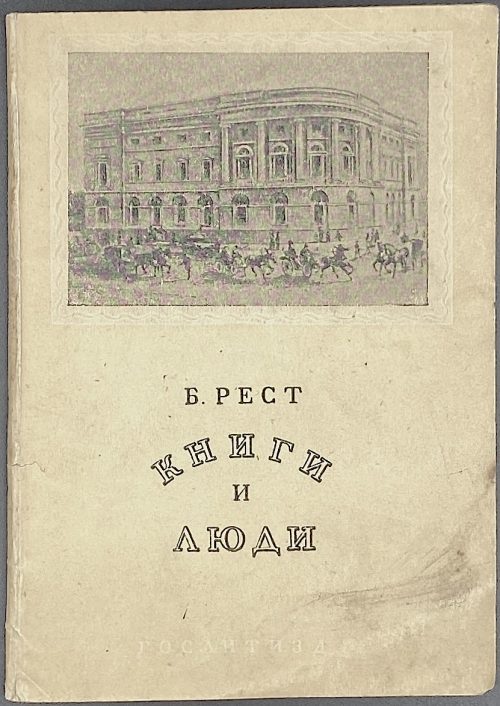 Softcover, original wrappers, 16 x 11 cm, collated 8vo: 48, 54, total 36 leaves, pp.: [2] 3-71 [72]. Front wrapper (lettered in black and white): {photo} | Б. РЕСТ. | КНИГИ | И | ЛЮДИ | ГОСЛИТИЗДАТ || Title-page (black and red): Б. РЕСТ | КНИГИ И ЛЮДИ | ОЧЕРКИ ИЗ ИСТОРИИ ГОСУДАРСТВЕННОЙ | ПУБЛИЧНОЙ БИБЛИОТЕКИ | имени | М. Е. САЛТЫКОВА-ЩЕДРИНА | 1814 — 1939 | {vignette} | — | Государственное издательство | “ХУДОЖЕСТВЕННАЯ ЛИТЕРАТУРА” | Ленинград 1939 || Print run: 7,500 copies. B. Rest [Б. Рест; Юлий Исаакович Шапиро] (Jewish-Russian, fl. 1940 – 1980).
Softcover, original wrappers, 16 x 11 cm, collated 8vo: 48, 54, total 36 leaves, pp.: [2] 3-71 [72]. Front wrapper (lettered in black and white): {photo} | Б. РЕСТ. | КНИГИ | И | ЛЮДИ | ГОСЛИТИЗДАТ || Title-page (black and red): Б. РЕСТ | КНИГИ И ЛЮДИ | ОЧЕРКИ ИЗ ИСТОРИИ ГОСУДАРСТВЕННОЙ | ПУБЛИЧНОЙ БИБЛИОТЕКИ | имени | М. Е. САЛТЫКОВА-ЩЕДРИНА | 1814 — 1939 | {vignette} | — | Государственное издательство | “ХУДОЖЕСТВЕННАЯ ЛИТЕРАТУРА” | Ленинград 1939 || Print run: 7,500 copies. B. Rest [Б. Рест; Юлий Исаакович Шапиро] (Jewish-Russian, fl. 1940 – 1980). -
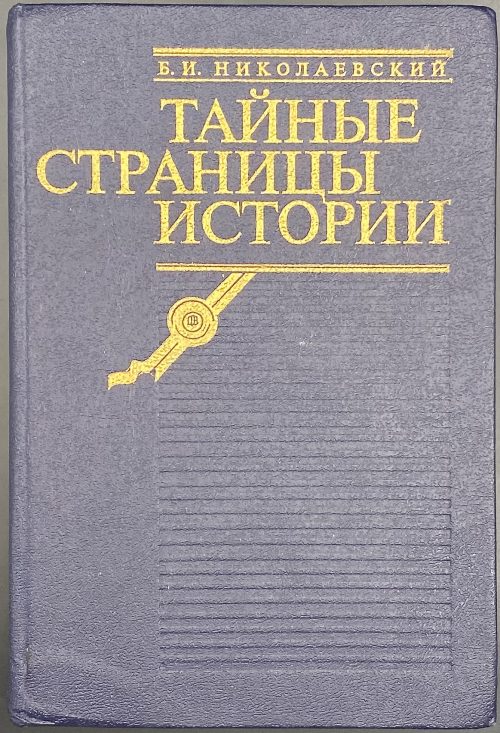 Hardcover volume, 22.2 x 15 cm, bound in blind-stamped blue buckram with gilt lettering to front cover and spine, pp.: [1-4] h.t., t.p., 5-507 [508] [4] contents/colophon, advert.; collated in 16mo (1-1616), 256 leaves, 512 pages. Title-page: Б. И. НИКОЛАЕВСКИЙ | ТАЙНЫЕ | СТРАНИЦЫ | ИСТОРИИ | ЛЕНИН И ДЕНЬГИ / БОЛЬШЕВИСТСКОЙ ОРГАНИЗАЦИИ | БИОГРАФИЯ МАЛЕНКОВА | ГЕРМАНИЯ / И РУССКИЕ РЕВОЛЮЦИОНЕРЫ / В ГОДЫ ПЕРВОЙ МИРОВОЙ / ВОЙНЫ | ПРОТОКОЛЫ ПОЛИТБЮРО / И ДОКУМЕНТЫ ОСОБОГО ОТДЕЛА / НКИД СССР, 1934 | Москва | Издательство | гуманитарной литературы | 1995 || Print run: 2,000 copies. Contributors: Борис Иванович Николаевский [Boris Nicolaevsky] (Russian-American, 1887 – 1966) – author. Юрий Георгиевич Фельштинский [Yuri Felshtinsky] (Jewish-Russian-American, b. 1956) – editor/compiler. ISBN: 5-87121-007-4. History's secret pages.
Hardcover volume, 22.2 x 15 cm, bound in blind-stamped blue buckram with gilt lettering to front cover and spine, pp.: [1-4] h.t., t.p., 5-507 [508] [4] contents/colophon, advert.; collated in 16mo (1-1616), 256 leaves, 512 pages. Title-page: Б. И. НИКОЛАЕВСКИЙ | ТАЙНЫЕ | СТРАНИЦЫ | ИСТОРИИ | ЛЕНИН И ДЕНЬГИ / БОЛЬШЕВИСТСКОЙ ОРГАНИЗАЦИИ | БИОГРАФИЯ МАЛЕНКОВА | ГЕРМАНИЯ / И РУССКИЕ РЕВОЛЮЦИОНЕРЫ / В ГОДЫ ПЕРВОЙ МИРОВОЙ / ВОЙНЫ | ПРОТОКОЛЫ ПОЛИТБЮРО / И ДОКУМЕНТЫ ОСОБОГО ОТДЕЛА / НКИД СССР, 1934 | Москва | Издательство | гуманитарной литературы | 1995 || Print run: 2,000 copies. Contributors: Борис Иванович Николаевский [Boris Nicolaevsky] (Russian-American, 1887 – 1966) – author. Юрий Георгиевич Фельштинский [Yuri Felshtinsky] (Jewish-Russian-American, b. 1956) – editor/compiler. ISBN: 5-87121-007-4. History's secret pages. -
![Аполлон Григорьев. Воспоминания / Ред. и коммент. Иванова-Разумника. Супер-обложка худ. В. М. Конашевича, тиснение на переплете худ. А. А. Ушина. – М., Л.: Academia, 1930. – (Памятники литературного быта. Воспоминания Аполлона Григорьева и воспоминания о нем). – Тир. 5070 экз. – pp.: [i-v] vi-viii, [1-3] 4-697 [3].](https://varshavskycollection.com/wp-content/uploads/2021/02/LIB-2532.2020-a-500x674.jpeg) Title page: АПОЛЛОН ГРИГОРЬЕВ | ВОСПОМИНАНИЯ | РЕДАКЦИЯ И КОММЕНТАРИИ | ИВАНОВА – РАЗУМНИКА | « ACADEMIA» | МОСКВА — ЛЕНИНГРАД | 1930 || Duplicate title: ПАМЯТНИКИ | ЛИТЕРАТУРНОГО | БЫТА | ВОСПОМИНАНИЯ | АПОЛЛОНА ГРИГОРЬЕВА | И ВОСПОМИНАНИЯ О НЕМ | «ACADEMIA» | МОСКВА — ЛЕНИНГРАД | 1930 || Title verso: Супер-обложка | худ. В. М. Конашевича | Тиснение на переплете | худ. А. А. Ушина | {imprint} || Print run: 5070 copies. Pagination: [i-v] vi-viii, [1-3] 4-697 [3]. Collation: 8vo; π4, 1-428, Ω14 (total 345 leaves) + 1 plate (photomechanical portrait frontispiece). Note: 11 unsigned. Binding: 18 x 13 cm; purple cloth, gilt-stamped with geometrical design, gilt lettering to spine, pictorial DJ (short, 16 cm). Catalogue raisonné: Крылов-Кичатова (2004): № 403, p.210. Григорьев, Аполлон Александрович (Russian, 1822 – 1864) – character, author. Конашевич, Владимир Михайлович (Russian, 1888 – 1963) – artist. Ушин, Алексей Алексеевич (Russian, 1904 – 1942) – artist.
Title page: АПОЛЛОН ГРИГОРЬЕВ | ВОСПОМИНАНИЯ | РЕДАКЦИЯ И КОММЕНТАРИИ | ИВАНОВА – РАЗУМНИКА | « ACADEMIA» | МОСКВА — ЛЕНИНГРАД | 1930 || Duplicate title: ПАМЯТНИКИ | ЛИТЕРАТУРНОГО | БЫТА | ВОСПОМИНАНИЯ | АПОЛЛОНА ГРИГОРЬЕВА | И ВОСПОМИНАНИЯ О НЕМ | «ACADEMIA» | МОСКВА — ЛЕНИНГРАД | 1930 || Title verso: Супер-обложка | худ. В. М. Конашевича | Тиснение на переплете | худ. А. А. Ушина | {imprint} || Print run: 5070 copies. Pagination: [i-v] vi-viii, [1-3] 4-697 [3]. Collation: 8vo; π4, 1-428, Ω14 (total 345 leaves) + 1 plate (photomechanical portrait frontispiece). Note: 11 unsigned. Binding: 18 x 13 cm; purple cloth, gilt-stamped with geometrical design, gilt lettering to spine, pictorial DJ (short, 16 cm). Catalogue raisonné: Крылов-Кичатова (2004): № 403, p.210. Григорьев, Аполлон Александрович (Russian, 1822 – 1864) – character, author. Конашевич, Владимир Михайлович (Russian, 1888 – 1963) – artist. Ушин, Алексей Алексеевич (Russian, 1904 – 1942) – artist. -
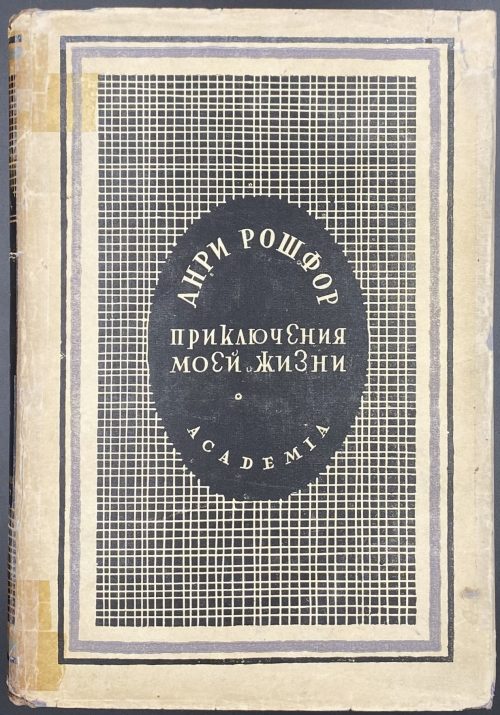 Title (in black and red): АНРИ РОШФОР | ПРИКЛЮЧЕНИЯ МОЕЙ ЖИЗНИ | ПЕРЕВОД, ВСТУПИТЕЛЬНАЯ | СТАТЬЯ И ПРИМЕЧАНИЯ | Е. СМИРНОВА | ACADEMIA | 1933 || Opposite title: ИНОСТРАННЫЕ МЕМУАРЫ, ДНЕВНИКИ, | ПИСЬМА И МАТЕРИАЛЫ | Под редакцией И. Т. Смилги ( whited-out) | АНРИ РОШФОР | 1831—1913 | ACADEMIA | МОСКВА — ЛЕНИНГРАД || Title verso: Henri Rochefort | Les Aventures de ma vie. | Переплет и суперобложка | по рисункам М. В. Ушакова-Поскочина. Pagination: [1, 2] – publisher’s device / blank, [3, 4] – opposite title, [5, 6] – t.p. / orig. title, 7-452 [453-460], ill. Collation: [1]-288 296 + 15 plates extraneous to collation. Binding: burgundy cloth ruled blind and stamped in gilt with a lantern to cover and lettering to spine, pictorial DJ; top margin red. Catalogue raisonné: Крылов, Е. В. Кичатова. "Academia" (2004): p. 237-8. Ушаков [Ушаков-Поскочин], Максим Владимирович (Russian, 1893 – 1943) – died in NKVD labor camp. Смилга, Ивар Тенисович (Latvian-Russian, 1892 – 1937) — shot dead by NKVD firing squad.
Title (in black and red): АНРИ РОШФОР | ПРИКЛЮЧЕНИЯ МОЕЙ ЖИЗНИ | ПЕРЕВОД, ВСТУПИТЕЛЬНАЯ | СТАТЬЯ И ПРИМЕЧАНИЯ | Е. СМИРНОВА | ACADEMIA | 1933 || Opposite title: ИНОСТРАННЫЕ МЕМУАРЫ, ДНЕВНИКИ, | ПИСЬМА И МАТЕРИАЛЫ | Под редакцией И. Т. Смилги ( whited-out) | АНРИ РОШФОР | 1831—1913 | ACADEMIA | МОСКВА — ЛЕНИНГРАД || Title verso: Henri Rochefort | Les Aventures de ma vie. | Переплет и суперобложка | по рисункам М. В. Ушакова-Поскочина. Pagination: [1, 2] – publisher’s device / blank, [3, 4] – opposite title, [5, 6] – t.p. / orig. title, 7-452 [453-460], ill. Collation: [1]-288 296 + 15 plates extraneous to collation. Binding: burgundy cloth ruled blind and stamped in gilt with a lantern to cover and lettering to spine, pictorial DJ; top margin red. Catalogue raisonné: Крылов, Е. В. Кичатова. "Academia" (2004): p. 237-8. Ушаков [Ушаков-Поскочин], Максим Владимирович (Russian, 1893 – 1943) – died in NKVD labor camp. Смилга, Ивар Тенисович (Latvian-Russian, 1892 – 1937) — shot dead by NKVD firing squad. -
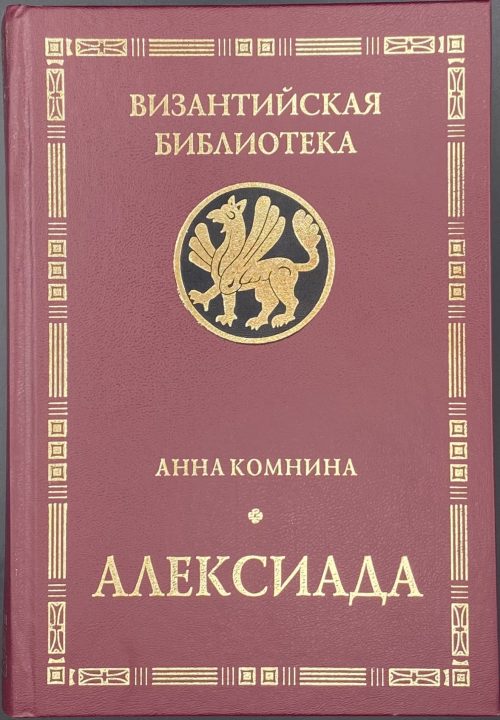 Title: АННА КОМНИНА | АЛЕКСИАДА | Перевод, комментарий и статьи | Я. Н. Любарского | Издание третье, исправленное и дополненное | Санкт-Петербург | АЛЕТЕЙЯ | 2010 || Series: Византийская библиотека. Источники. Pagination: [i-v] vi-lxvi [1] 2-682 [4]. Binding: 21.5 x 15 cm; hardcover, crimson buckram, gilt lettering, border and serial device on black. Edition: 3rd edition. Print run: 1,000 copies. ISBN: 978-5-91419-301-7. Anna Komnene [Άννα Κομνηνή; Anna Comnena] (Byzantine, 1083 – 1150s). Любарский, Яков Николаевич (Russian, 1929 – 2003)
Title: АННА КОМНИНА | АЛЕКСИАДА | Перевод, комментарий и статьи | Я. Н. Любарского | Издание третье, исправленное и дополненное | Санкт-Петербург | АЛЕТЕЙЯ | 2010 || Series: Византийская библиотека. Источники. Pagination: [i-v] vi-lxvi [1] 2-682 [4]. Binding: 21.5 x 15 cm; hardcover, crimson buckram, gilt lettering, border and serial device on black. Edition: 3rd edition. Print run: 1,000 copies. ISBN: 978-5-91419-301-7. Anna Komnene [Άννα Κομνηνή; Anna Comnena] (Byzantine, 1083 – 1150s). Любарский, Яков Николаевич (Russian, 1929 – 2003) -
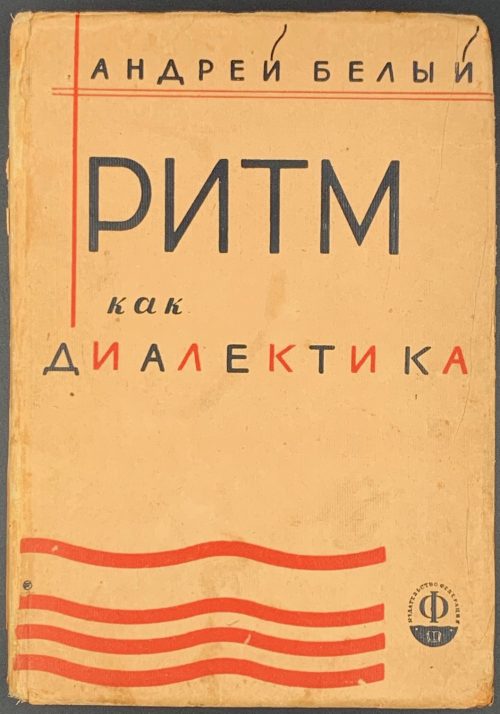 Hardcover, 19.8 x 14 cm, tan paper over cardboard with black and red lettering and design elements to front, black lettering to back and spine, pp.: fep, [1-8] (publ. device/blank, t.p./imprint, foreword, f.t./blank), [9] intro, 10-279 [280] contents, fep; blue crayon to fep recto Ф. Аншуков, ink mark to t.p. К. Collated 8vo: 1-178, 184, total 140 leaves. Title-page: АНДРЕЙ БЕЛЫЙ | РИТМ | КАК ДИАЛЕКТИКА | И | «МЕДНЫЙ ВСАДНИК» | ИССЛЕДОВАНИЕ | ИЗДАТЕЛЬСТВО | «ФЕДЕРАЦИЯ» | МОСКВА – 1929 || Contributors: Андрей Белый [Andrei Bely, Борис Николаевич Бугаев] (Russian, 1880 – 1934) – author.
Hardcover, 19.8 x 14 cm, tan paper over cardboard with black and red lettering and design elements to front, black lettering to back and spine, pp.: fep, [1-8] (publ. device/blank, t.p./imprint, foreword, f.t./blank), [9] intro, 10-279 [280] contents, fep; blue crayon to fep recto Ф. Аншуков, ink mark to t.p. К. Collated 8vo: 1-178, 184, total 140 leaves. Title-page: АНДРЕЙ БЕЛЫЙ | РИТМ | КАК ДИАЛЕКТИКА | И | «МЕДНЫЙ ВСАДНИК» | ИССЛЕДОВАНИЕ | ИЗДАТЕЛЬСТВО | «ФЕДЕРАЦИЯ» | МОСКВА – 1929 || Contributors: Андрей Белый [Andrei Bely, Борис Николаевич Бугаев] (Russian, 1880 – 1934) – author. -
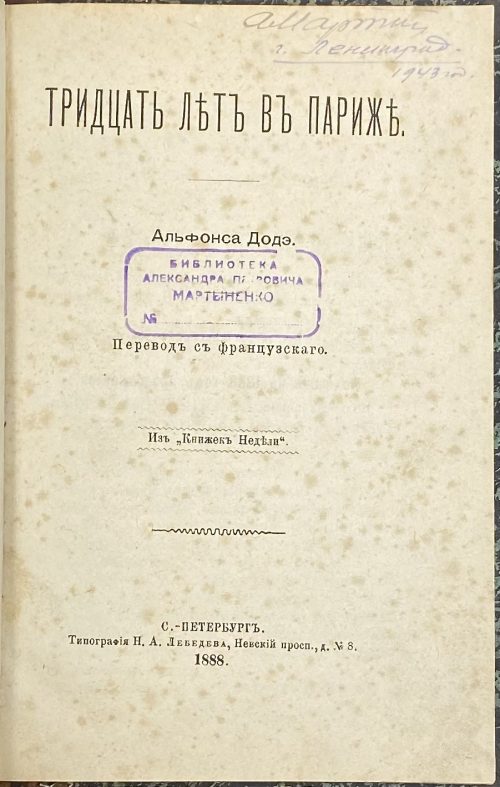 Russian translation of: Alphonse Daudet. Trente ans de Paris à travers ma vie et mes livres; (Collection artistique Guillaume et Cie). — Paris: C. Marpon et E. Flammarion, 1888. Series: Книжки Недели, №2-4, 1888. Title: ТРИДЦАТЬ ЛѢТ ВЪ ПАРИЖѢ. | Альфонса Додэ. | Переводъ съ французскаго. | {in waving rules} Изъ "Книжекъ недѣли". | {waving rule} | С.-ПЕТЕРБУРГЪ. | Типографiя Н. А. Лебедева. Невскiй просп., д. № 8. | 1888. || Pagination:[2] [1] 2-108 [2] – back wrapper; total number of pages 112. Collation: 8vo; π7 1-28 7-88 98 78 (six 8vo gatherings) ω1; total number of leaves 56. Binding: 24 x 16.5 cm quarter brown morocco over marbled boards, blind lettering to spine; personal library stamp to a number of pages: “БИБЛИОТЕКА | АЛЕКСАНДРА ПЕТРОВИЧА | МАРТЫНЕНКО | №»; handwritten inscription to front flyleaf: «А. Мартыненко, г. Ленинград, 1943 г.» Contributors: Alphonse Daudet (French, 1840 – 1897) – author of the text. Лебедев, Николай Афанасьевич (Russian, 1813 – 1896) – printer. Гайдебуров, Павел Александрович (Russian, 1841 – 1893/4) – publisher.
Russian translation of: Alphonse Daudet. Trente ans de Paris à travers ma vie et mes livres; (Collection artistique Guillaume et Cie). — Paris: C. Marpon et E. Flammarion, 1888. Series: Книжки Недели, №2-4, 1888. Title: ТРИДЦАТЬ ЛѢТ ВЪ ПАРИЖѢ. | Альфонса Додэ. | Переводъ съ французскаго. | {in waving rules} Изъ "Книжекъ недѣли". | {waving rule} | С.-ПЕТЕРБУРГЪ. | Типографiя Н. А. Лебедева. Невскiй просп., д. № 8. | 1888. || Pagination:[2] [1] 2-108 [2] – back wrapper; total number of pages 112. Collation: 8vo; π7 1-28 7-88 98 78 (six 8vo gatherings) ω1; total number of leaves 56. Binding: 24 x 16.5 cm quarter brown morocco over marbled boards, blind lettering to spine; personal library stamp to a number of pages: “БИБЛИОТЕКА | АЛЕКСАНДРА ПЕТРОВИЧА | МАРТЫНЕНКО | №»; handwritten inscription to front flyleaf: «А. Мартыненко, г. Ленинград, 1943 г.» Contributors: Alphonse Daudet (French, 1840 – 1897) – author of the text. Лебедев, Николай Афанасьевич (Russian, 1813 – 1896) – printer. Гайдебуров, Павел Александрович (Russian, 1841 – 1893/4) – publisher. -
![Манцони Алессандро. Обрученные. Повесть из истории Милана XVII века. Пер.и комм. И.И.Штица. Вст.ст А.К.Дживелегова. Илл. Е.Д.Белухи // Серия: Итальянская лит-ра. — М.-Л.: Academia, 1936. — XXXVIII, 952 стр., 15 илл. Тираж: 5300 экз. [том выходил без супера].](https://varshavskycollection.com/wp-content/uploads/2021/02/LIB-1333-a-500x670.jpg) Title page: АЛЕССАНДРО МАНЦОНИ | ОБРУЧЕННЫЕ | ПОВЕСТЬ ИЗ ИСТОРИИ | МИЛАНА XVII ВЕКА | ПЕРЕВОД И КОММЕНТАРИИ | И. И. ШИТЦА | ВСТУПИТЕЛЬНАЯ СТАТЬЯ | А. К ДЖИВЕЛЕГОВА | ACADEMIA | 1936 || Frontispiece: ИТАЛЬЯНСКАЯ ЛИТЕРАТУРА | ПОД ОБЩЕЙ РЕДАКЦИЕЙ А. К ДЖИВЕЛЕГОВА | АЛЕССАНДРО | МАНЦОНИ | 1785 — 1873 | ACADEMIA | МОСКВА ЛЕНИНГРАД || Title verso: ALESSANDRO MANZONI | I PROMESSI SPOSI | Иллюстрации — автолитография | Е. Д. Белухи | Титула и переплет | по его же рисунку || Pagination: [i-vii] viii-xxxviii [2] [2] 3-946 [8] + 15 leaves of illustrations. Collation: [I]8 II8 III4 1-598 ⅛605 + 5 leaves of plates + 10 leaves of plates (lithography by Е. Д. Белуха). Binding: 19.5 x 14.5 cm; Publisher’s blue cloth, lettering and design to cover and spine (by Е. Д. Белуха). Print run: 5300 copies. Catalogue raisonné: Крылов-Кичатова (2004): №832, p. 279. Contributors: Мандзони, Алессандро [Manzoni, Alessandro] (Italian, 1785 – 1873) – author of the original text. Шитц, Иван Иванович (Russian, 1874—1942) – translator from the Italian into Russian. Дживелегов, Алексей Карпович (Russian, 1875 – 1952) – editor. Белуха, Евгений Дмитриевич (Russian, 1889 – 1943) – artist. For the first English edition see: [LIB-1332.2017]: Alessandro Manzoni. The betrothed / (Standard novels). — London: R. Bentley, 1834.
Title page: АЛЕССАНДРО МАНЦОНИ | ОБРУЧЕННЫЕ | ПОВЕСТЬ ИЗ ИСТОРИИ | МИЛАНА XVII ВЕКА | ПЕРЕВОД И КОММЕНТАРИИ | И. И. ШИТЦА | ВСТУПИТЕЛЬНАЯ СТАТЬЯ | А. К ДЖИВЕЛЕГОВА | ACADEMIA | 1936 || Frontispiece: ИТАЛЬЯНСКАЯ ЛИТЕРАТУРА | ПОД ОБЩЕЙ РЕДАКЦИЕЙ А. К ДЖИВЕЛЕГОВА | АЛЕССАНДРО | МАНЦОНИ | 1785 — 1873 | ACADEMIA | МОСКВА ЛЕНИНГРАД || Title verso: ALESSANDRO MANZONI | I PROMESSI SPOSI | Иллюстрации — автолитография | Е. Д. Белухи | Титула и переплет | по его же рисунку || Pagination: [i-vii] viii-xxxviii [2] [2] 3-946 [8] + 15 leaves of illustrations. Collation: [I]8 II8 III4 1-598 ⅛605 + 5 leaves of plates + 10 leaves of plates (lithography by Е. Д. Белуха). Binding: 19.5 x 14.5 cm; Publisher’s blue cloth, lettering and design to cover and spine (by Е. Д. Белуха). Print run: 5300 copies. Catalogue raisonné: Крылов-Кичатова (2004): №832, p. 279. Contributors: Мандзони, Алессандро [Manzoni, Alessandro] (Italian, 1785 – 1873) – author of the original text. Шитц, Иван Иванович (Russian, 1874—1942) – translator from the Italian into Russian. Дживелегов, Алексей Карпович (Russian, 1875 – 1952) – editor. Белуха, Евгений Дмитриевич (Russian, 1889 – 1943) – artist. For the first English edition see: [LIB-1332.2017]: Alessandro Manzoni. The betrothed / (Standard novels). — London: R. Bentley, 1834. -
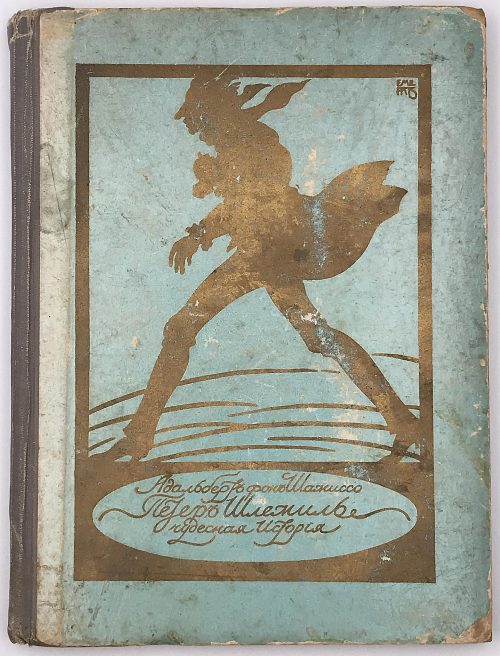
Шамиссо, Адальбертъ фонъ. Петеръ Шлемиль. Чудесная исторiя. Пер. П.Потемкина. Рис., виньетки и перепет Эмиля Преторiуса по 1-му нѣм. изд. 1814 г. — СПб.: Книгоиздательство "Пантеонъ", 1910. — 107 стр. Отпечатано в типографии акц. о-ва типографск. дела в СПБ (Герольд), 7 рота, 26.
Cardboard binding, 8vo, 20 x 15 cm. Russian translation of Adelbert von Chamisso book Peter Schlemihl, from the German by Peter Potemkine. With illustrations from 1814 original German first edition by Emil Preetorius. [SV: the latest statement seems strange as Emil Preetorius lived from 1883 to 1973]. -
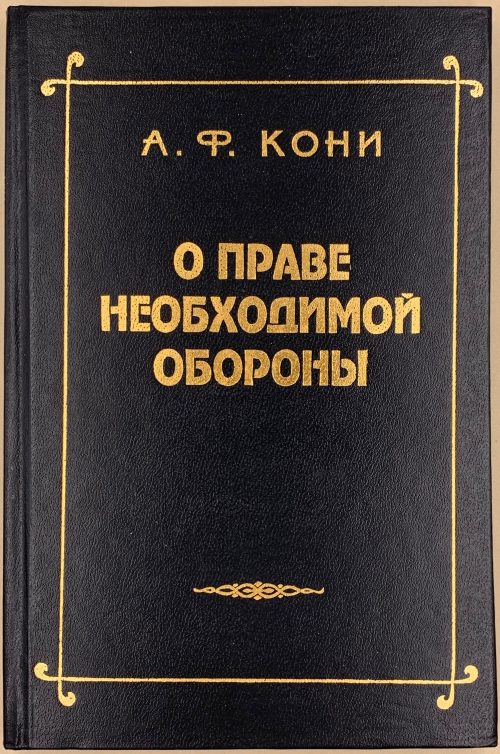 Hardcover volume, 20.8 x 13.8 cm, bound in black buckram with gilt lettering to front cover and spine; pp.: [2] 3-112. Portrait of young Anatoly Koni to fep verso. Print run: 5,000 copies. About the right of the defence of necessity – a reprint of the first work of distinguished Russian jurist Anatoly Koni, originally published in «Приложение к Университетским известиям» in 1865 and Кони А. О правѣ необходимой обороны. Рассужденiе. - М.: В Университетской Типографiи, 1866.
Hardcover volume, 20.8 x 13.8 cm, bound in black buckram with gilt lettering to front cover and spine; pp.: [2] 3-112. Portrait of young Anatoly Koni to fep verso. Print run: 5,000 copies. About the right of the defence of necessity – a reprint of the first work of distinguished Russian jurist Anatoly Koni, originally published in «Приложение к Университетским известиям» in 1865 and Кони А. О правѣ необходимой обороны. Рассужденiе. - М.: В Университетской Типографiи, 1866. -
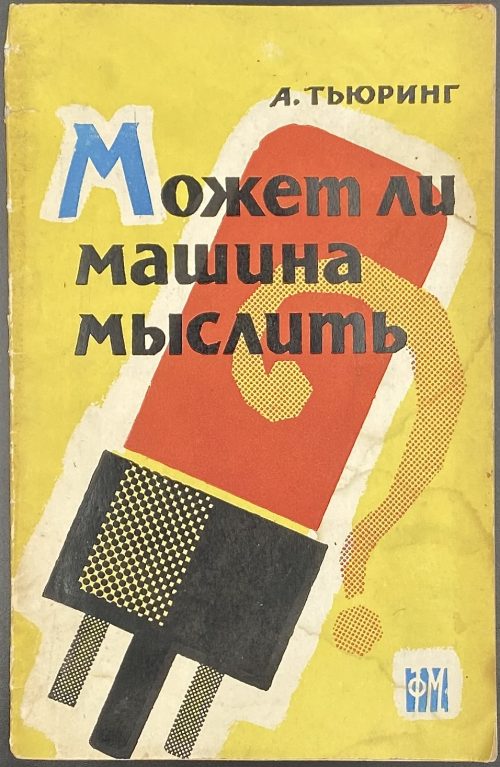 А. Тьюринг. Может ли машина мыслить? / С прил. ст. Дж. фон Неймана "Общая и логическая теория автоматов"; пер. с англ. Ю. А. Данилова; ред. и пред. С. А. Яновской. — М.: Физматгиз, 1960. Title page: А. ТЬЮРИНГ | МОЖЕТ ЛИ | МАШИНА МЫСЛИТЬ? | С приложением статьи ДЖ. фон НЕЙМАНА | ОБЩАЯ И ЛОГИЧЕСКАЯ ТЕОРИЯ АВТОМАТОВ | Перевод с английского | Ю. А. Данилова | Редакция и предисловие | проф. С. А. Яновской | {Publisher’s device «ФМ» | ГОСУДАРСТВЕННОЕ ИЗДАТЕЛЬСТВО | ФИЗИКО-МАТЕМАТИЧЕСКОЙ ЛИТЕРАТУРЫ | МОСКВА 1960 || Pagination: [2] 3-110 [2]. Collation: [1]8, 2-416; 11 (t.p./contents, imprint.) unsigned. Size: 20 x 13 cm Binding: Softcover, front pictorial wrapper – yellow background and radio lamp, lettering: А. Тьюринг. Может ли | машина | мыслить | ? | {publisher's device white on blue "ФМ"} || Contributors: Turing, Alan Mathison (British, 1912 – 1954) – author of the text. John von Neumann (American-Hungarian, 1903 – 1957) – author of the text. Данилов, Юлий Александрович (Russian, 1936 – 2003) – translator. Яновская [Неймарк], Софья Александровна (Russian-Jewish, 1896 – 1966) – author of preface, editor.
А. Тьюринг. Может ли машина мыслить? / С прил. ст. Дж. фон Неймана "Общая и логическая теория автоматов"; пер. с англ. Ю. А. Данилова; ред. и пред. С. А. Яновской. — М.: Физматгиз, 1960. Title page: А. ТЬЮРИНГ | МОЖЕТ ЛИ | МАШИНА МЫСЛИТЬ? | С приложением статьи ДЖ. фон НЕЙМАНА | ОБЩАЯ И ЛОГИЧЕСКАЯ ТЕОРИЯ АВТОМАТОВ | Перевод с английского | Ю. А. Данилова | Редакция и предисловие | проф. С. А. Яновской | {Publisher’s device «ФМ» | ГОСУДАРСТВЕННОЕ ИЗДАТЕЛЬСТВО | ФИЗИКО-МАТЕМАТИЧЕСКОЙ ЛИТЕРАТУРЫ | МОСКВА 1960 || Pagination: [2] 3-110 [2]. Collation: [1]8, 2-416; 11 (t.p./contents, imprint.) unsigned. Size: 20 x 13 cm Binding: Softcover, front pictorial wrapper – yellow background and radio lamp, lettering: А. Тьюринг. Может ли | машина | мыслить | ? | {publisher's device white on blue "ФМ"} || Contributors: Turing, Alan Mathison (British, 1912 – 1954) – author of the text. John von Neumann (American-Hungarian, 1903 – 1957) – author of the text. Данилов, Юлий Александрович (Russian, 1936 – 2003) – translator. Яновская [Неймарк], Софья Александровна (Russian-Jewish, 1896 – 1966) – author of preface, editor. -
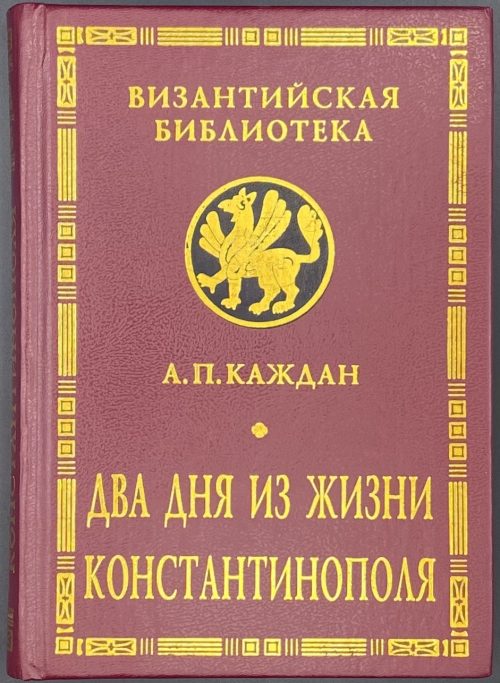 Title: А. П. КАЖДАН | ДВА ДНЯ | ИЗ ЖИЗНИ | КОНСТАНТИНОПОЛЯ | Научное издание | Издательство «АЛЕТЕЙЯ» | Санкт-Петербург | 2002 || Series: Византийская библиотека. Исследования. Pagination: [1-5] 6-318 [2], il. in text. Binding: 17 x 12.5 cm; hardcover, crimson buckram, gilt lettering, border and serial device on black. Print run: 1,300 copies. ISBN: 5-89329-463-7. Каждан, Александр Петрович [Пейсахович] [Kazhdan, Alexander] (Russian-American, 1922 – 1997).
Title: А. П. КАЖДАН | ДВА ДНЯ | ИЗ ЖИЗНИ | КОНСТАНТИНОПОЛЯ | Научное издание | Издательство «АЛЕТЕЙЯ» | Санкт-Петербург | 2002 || Series: Византийская библиотека. Исследования. Pagination: [1-5] 6-318 [2], il. in text. Binding: 17 x 12.5 cm; hardcover, crimson buckram, gilt lettering, border and serial device on black. Print run: 1,300 copies. ISBN: 5-89329-463-7. Каждан, Александр Петрович [Пейсахович] [Kazhdan, Alexander] (Russian-American, 1922 – 1997). -
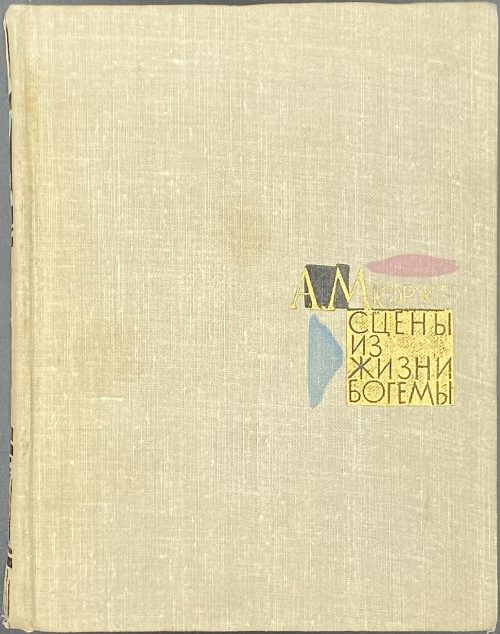 Hardcover volume, 17.2 x 13.6 cm, bound in grey cloth with colour design elements and black and gilt lettering to front cover and spine, pp: [1-4] 5-455 [456]; collated 8vo: 1-228, 23-2410, 25-288; total 228 leaves. Frontispiece and headpieces – woodcuts by Н. А. Кравченко. Bookplate “EX LIBRIS | Д. И. Ривкиной” to front pastedown. Half-title: ГОСУДАРСТВЕННОЕ | ИЗДАТЕЛЬСТВО | ХУДОЖЕСТВЕННОЙ | ЛИТЕРАТУРЫ | Москва 1963 || Title-page: А. МЮРЖЕ | СЦЕНЫ | ИЗ | ЖИЗНИ | БОГЕМЫ | {lyre} | Перевод с французского | Е. А. ГУНСТА || Title-page verso: HENRY MURGER | SCÈNES | de la | VIE DE BOHÈME | 1851 | Редактор перевода | Е. Н. БИРУКОВА | Вступительная статья | С. И. ВЕЛИКОВСКОГО | Примечания | Е. А. ГУНСТА | Художник | Н. А. КРАВЧЕНКО || Print run: 50,000 copies. Сцены из жизни богемы [Scènes de la vie de bohème]; First edition: Henry Murger. Scènes de la bohême. — Paris: M. Lévy frères, 1851 [LIB-2732.2021]. Contributors: Murger, Henri [Henry] (French, 1822 – 1861) – original text (French). Евгений Анатольевич Гунст (Russian, 1901 – 1983) – translation, commentary. Самарий Израилевич Великовский (Russian, 1931 – 1990) – foreword. Наталья Алексеевна Кравченко (Russian, 1916 – 2017) – atrist. Д. И. Ривкина – provenance.
Hardcover volume, 17.2 x 13.6 cm, bound in grey cloth with colour design elements and black and gilt lettering to front cover and spine, pp: [1-4] 5-455 [456]; collated 8vo: 1-228, 23-2410, 25-288; total 228 leaves. Frontispiece and headpieces – woodcuts by Н. А. Кравченко. Bookplate “EX LIBRIS | Д. И. Ривкиной” to front pastedown. Half-title: ГОСУДАРСТВЕННОЕ | ИЗДАТЕЛЬСТВО | ХУДОЖЕСТВЕННОЙ | ЛИТЕРАТУРЫ | Москва 1963 || Title-page: А. МЮРЖЕ | СЦЕНЫ | ИЗ | ЖИЗНИ | БОГЕМЫ | {lyre} | Перевод с французского | Е. А. ГУНСТА || Title-page verso: HENRY MURGER | SCÈNES | de la | VIE DE BOHÈME | 1851 | Редактор перевода | Е. Н. БИРУКОВА | Вступительная статья | С. И. ВЕЛИКОВСКОГО | Примечания | Е. А. ГУНСТА | Художник | Н. А. КРАВЧЕНКО || Print run: 50,000 copies. Сцены из жизни богемы [Scènes de la vie de bohème]; First edition: Henry Murger. Scènes de la bohême. — Paris: M. Lévy frères, 1851 [LIB-2732.2021]. Contributors: Murger, Henri [Henry] (French, 1822 – 1861) – original text (French). Евгений Анатольевич Гунст (Russian, 1901 – 1983) – translation, commentary. Самарий Израилевич Великовский (Russian, 1931 – 1990) – foreword. Наталья Алексеевна Кравченко (Russian, 1916 – 2017) – atrist. Д. И. Ривкина – provenance. -
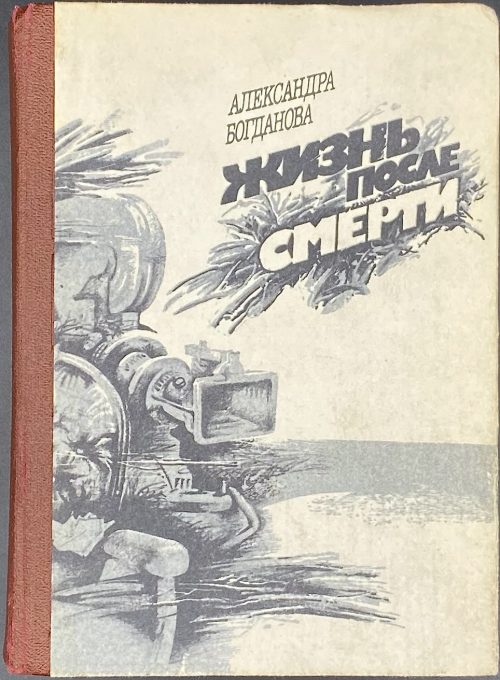 Hardcover, 17.2 x 12.5 cm, brown cloth-backed pictorial paper boards, lettering to front and spine, pictorial endpapers, pp.: [1-4] 5-430 [2], total 432 pages; collated in-16mo: [1]-1216 138 1416, total 216 leaves. Print run: 65,000 copies. A real history-based fiction about doctor Nikolai Sudzilovsky [Nicholas Russel] (Belarusian, 1850 – 1930). Title-page (pictorial): АЛЕКСАНДРА | БОГДАНОВА | ЖИЗНЬ | ПОСЛЕ | СМЕРТИ | Роман || Imprint: Рецензент доктор филилогических наук Н. Г. Жулинский. Редактор В. А. Лигостов. Богданова А. И. Жизнь после смерти: Роман. — К.: Рад. письменник, 1990. — 431 с. ISBN 5-333-00201-0. Colophon: Литературно-художественное издание. БОГДАНОВА АЛЕКСАНДРА ИВАНОВНА | Жизнь после смерти. Роман. Киев, издательство «Радяньский пысьмэннык». Author: Богданова, Александра Ивановна (b. c. 1950).
Hardcover, 17.2 x 12.5 cm, brown cloth-backed pictorial paper boards, lettering to front and spine, pictorial endpapers, pp.: [1-4] 5-430 [2], total 432 pages; collated in-16mo: [1]-1216 138 1416, total 216 leaves. Print run: 65,000 copies. A real history-based fiction about doctor Nikolai Sudzilovsky [Nicholas Russel] (Belarusian, 1850 – 1930). Title-page (pictorial): АЛЕКСАНДРА | БОГДАНОВА | ЖИЗНЬ | ПОСЛЕ | СМЕРТИ | Роман || Imprint: Рецензент доктор филилогических наук Н. Г. Жулинский. Редактор В. А. Лигостов. Богданова А. И. Жизнь после смерти: Роман. — К.: Рад. письменник, 1990. — 431 с. ISBN 5-333-00201-0. Colophon: Литературно-художественное издание. БОГДАНОВА АЛЕКСАНДРА ИВАНОВНА | Жизнь после смерти. Роман. Киев, издательство «Радяньский пысьмэннык». Author: Богданова, Александра Ивановна (b. c. 1950). -
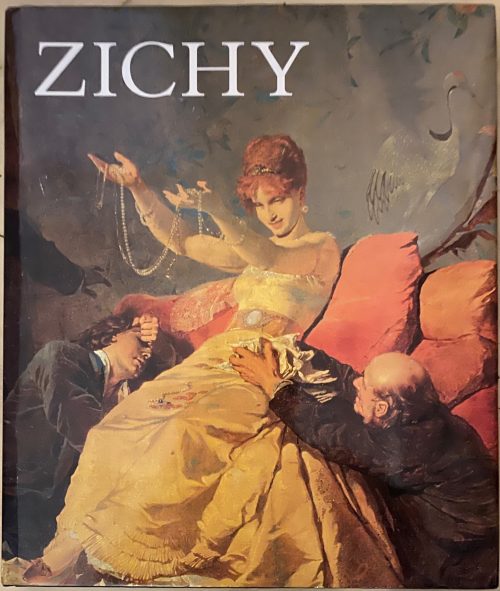 Title: ZICHI | A bevezető tanulmányt írta | és a képeket válogatta | GELLÉR KATALIN | Introduced and selected by | KATALIN GELLÉR | CORVINA || Pagination: [1-4] 5-44 + 34 leaves of illustrations, (66 plates). Exterior: 32.5 x 28 cm, hardcover, original dark green cloth with silver lettering to spine, pictorial DJ. Text in Hungarian and English. Artist: Mihály Zichy [Michael von Zichy] (Hungarian, 1827 – 1906).
Title: ZICHI | A bevezető tanulmányt írta | és a képeket válogatta | GELLÉR KATALIN | Introduced and selected by | KATALIN GELLÉR | CORVINA || Pagination: [1-4] 5-44 + 34 leaves of illustrations, (66 plates). Exterior: 32.5 x 28 cm, hardcover, original dark green cloth with silver lettering to spine, pictorial DJ. Text in Hungarian and English. Artist: Mihály Zichy [Michael von Zichy] (Hungarian, 1827 – 1906). -
 Iron tsuba of round form decorated with eight roundels – circular emblems of flowers and/or family crests (mon) made of cast brass, pierced and chiselled in kebori, and with flat brass inlay (hira-zōgan) of vines or leaves all over the plate. Both hitsu-ana are trimmed with brass. Nakago-ana of trapezoidal form. A distinctive character of this tsuba is a mon at 12 hours, depicting paulownia, or Kiri-mon [桐紋] – a symbol of the Toyotomi clan, led by Toyotomi Hideyoshi (豊臣 秀吉, 1537 – 1598). Kiri-mon was also used as fuku-mon (alternative family crests) for the Imperial Family and Imperial Court. Another important emblem at 6 o’clock is the Katakura clan [片倉氏, Katakura-shi] family crest. Katakura Kagetsuna (片倉 景綱, 1557 – 1615), a retainer of Date Masamune (伊達 政宗, 1567 – 1636); Kagetsuna was operational in Hideyoshi’s Odawara campaign in 1590, which ultimately ended the unification of Japan. Unsigned but may be attributed to Koike Yoshirō Naomasa or his workshop (Yoshirō, orKaga-Yoshirō school). Dimensions: Diameter: 85.5 mm; Thickness at seppa-dai: 5.0 mm.
Iron tsuba of round form decorated with eight roundels – circular emblems of flowers and/or family crests (mon) made of cast brass, pierced and chiselled in kebori, and with flat brass inlay (hira-zōgan) of vines or leaves all over the plate. Both hitsu-ana are trimmed with brass. Nakago-ana of trapezoidal form. A distinctive character of this tsuba is a mon at 12 hours, depicting paulownia, or Kiri-mon [桐紋] – a symbol of the Toyotomi clan, led by Toyotomi Hideyoshi (豊臣 秀吉, 1537 – 1598). Kiri-mon was also used as fuku-mon (alternative family crests) for the Imperial Family and Imperial Court. Another important emblem at 6 o’clock is the Katakura clan [片倉氏, Katakura-shi] family crest. Katakura Kagetsuna (片倉 景綱, 1557 – 1615), a retainer of Date Masamune (伊達 政宗, 1567 – 1636); Kagetsuna was operational in Hideyoshi’s Odawara campaign in 1590, which ultimately ended the unification of Japan. Unsigned but may be attributed to Koike Yoshirō Naomasa or his workshop (Yoshirō, orKaga-Yoshirō school). Dimensions: Diameter: 85.5 mm; Thickness at seppa-dai: 5.0 mm.
Kiri-mon

Katakura-mon
-
 Iron tsuba of round form decorated with eight circular emblems of flowers and/or family crests (mon) made of cast brass, pierced and chiseled in kebori, as well as with flat brass inlay (hira-zōgan) of vines, leaves, and flowers all over the plate. Yoshirō school (Kaga-Yoshirō). The Momoyama or early Edo period, 17th century. Size: diameter 80 mm, thickness at seppa-dai 3,6 mm. Symbols: [12:00 o'clock] - Wood sorrel (katabami) and swords ; [9:00] - Cherry blossom (sakura); [7:30] - Bellflower (kikyō), kamon of Toki clan; [3:00] - possibly, a six-petal Chrysanthemum (kiku) or a Passion flower (tessen); [1:30] - Hemp (asanoha). The symbols at 6:00, 10:30, and 4:30 o'clock seem to be geometrical patterns of auspicious meaning: a cross in a square, a four pointing star, and a diamond, respectively. Alternatively, we may look at this piece as purely decorative, with patterns at 12:00, 3:00, 6:00, and 9:00 o'clock in negative openwork (in-sukashi), and at 1:30, 4:40, 7:20, and 10:30 o'clock - in positive openwork (ji-sukashi, or yō-sukashi). Markus Sesko in his Handbook of sword fittings related terms [Herstellung und Verlag: Books on Demand GmbH, Norderstedt, 2011] discriminates this type of openwork in a separate class: Ranma-sukashi: "This term is applied to circular sukashi with family crests to their inside, which are arranged running along the rim area. The description goes back to the opened boards (ranma) between the sliding doors and the ceiling of Japanese rooms. Ranma-sukashi are mostly seen on old Heianjō- or Yoshirō-zōgan-tsuba but also on works of Hayashi Matashichi" [page 30].
Iron tsuba of round form decorated with eight circular emblems of flowers and/or family crests (mon) made of cast brass, pierced and chiseled in kebori, as well as with flat brass inlay (hira-zōgan) of vines, leaves, and flowers all over the plate. Yoshirō school (Kaga-Yoshirō). The Momoyama or early Edo period, 17th century. Size: diameter 80 mm, thickness at seppa-dai 3,6 mm. Symbols: [12:00 o'clock] - Wood sorrel (katabami) and swords ; [9:00] - Cherry blossom (sakura); [7:30] - Bellflower (kikyō), kamon of Toki clan; [3:00] - possibly, a six-petal Chrysanthemum (kiku) or a Passion flower (tessen); [1:30] - Hemp (asanoha). The symbols at 6:00, 10:30, and 4:30 o'clock seem to be geometrical patterns of auspicious meaning: a cross in a square, a four pointing star, and a diamond, respectively. Alternatively, we may look at this piece as purely decorative, with patterns at 12:00, 3:00, 6:00, and 9:00 o'clock in negative openwork (in-sukashi), and at 1:30, 4:40, 7:20, and 10:30 o'clock - in positive openwork (ji-sukashi, or yō-sukashi). Markus Sesko in his Handbook of sword fittings related terms [Herstellung und Verlag: Books on Demand GmbH, Norderstedt, 2011] discriminates this type of openwork in a separate class: Ranma-sukashi: "This term is applied to circular sukashi with family crests to their inside, which are arranged running along the rim area. The description goes back to the opened boards (ranma) between the sliding doors and the ceiling of Japanese rooms. Ranma-sukashi are mostly seen on old Heianjō- or Yoshirō-zōgan-tsuba but also on works of Hayashi Matashichi" [page 30]. -
 Iron tsuba of round form decorated with eight roundels - circular emblems of flowers and/or family crests (mon) made of cast brass, pierced and chiseled in kebori, and with flat brass inlay (hira-zōgan) of vines or seaweed all over the plate. Hitsu-ana outlined in brass. Four positive silhouette roundels are 3-, 4-, 5-, and 6- pointing crests/flowers; four negative silhouette roundels are bellflower, cherry blossom, and suhama. Yoshirō school (Kaga-Yoshirō). The Momoyama or early Edo period, beginning of 17th century. Size: diameter 77 mm, thickness 3,8 mm
Iron tsuba of round form decorated with eight roundels - circular emblems of flowers and/or family crests (mon) made of cast brass, pierced and chiseled in kebori, and with flat brass inlay (hira-zōgan) of vines or seaweed all over the plate. Hitsu-ana outlined in brass. Four positive silhouette roundels are 3-, 4-, 5-, and 6- pointing crests/flowers; four negative silhouette roundels are bellflower, cherry blossom, and suhama. Yoshirō school (Kaga-Yoshirō). The Momoyama or early Edo period, beginning of 17th century. Size: diameter 77 mm, thickness 3,8 mm -

Iron tsuba of round form decorated with eight roundels – circular emblems of flowers and/or family crests (mon) made of cast brass, pierced and chiseled in kebori, and with flat brass inlay (hira-zōgan) of vines or leaves all over the plate. Both hitsu-ana could have been trimmed with brass now lacking. Nakago-ana of triangular form, possibly enlarged, with copper sekigane. All typical emblems with bellflower, two variations on suhama theme, and 3, 4, 5, and 6-poinitng mon variations. A distinctive character of this tsuba is a mon at 12 hours depicting water plantain (omodaka).
“Omodaka was also called shōgunsō (victorious army grass); because of this martial connotation, it was a design favored for the crests of samurai families” [Family crests of Japan, Stone Bridge Press, Berkeley, California]. Yoshirō school (Kaga-Yoshirō). The Momoyama or early Edo period, beginning of 17th century. Size: Height: 81.4 mm; width: 81.2; thickness 3.8 mm at seppa-dai. -
 Iron tsuba of round form, tapering from centre to the rim, decorated with eight roundels – circular emblems of flowers and/or family crests (mon) made of cast brass, pierced and chiselled in kebori, and with flat brass inlay (hira-zōgan) of water plantain (omodaka) and seaweed all over the plate. Hitsu-ana outlined in brass. Four positive silhouette roundels are 3-, 6-, 9-, and 12 – pointing crests/flowers; four negative silhouette roundels – bellflower, cherry and plum blossoms. Yoshirō school (Kaga-Yoshirō). Unsigned. The Momoyama or early Edo period, end of the 16th to the first half of the 17th century (1574-1650). Size: H: 88.3 mm; W: 88.7 mm; Thickness 4.0 mm (Seppa-dai), 3,2 cm (rim). Other Kaga-Yoshiro tsuba in this collection: TSU-0334: 7.7 cm; TSU-0342.2017: 89.6 cm; TSU-0344: 8.1 cm; TSU-0329: 8.0 cm; TSU-0376.2018: 8.1 cm; TSU-0379.2018: 8.2 cm. We see that the usual size is about 8 cm; larger pieces, such as this one and TSU-0342.2017 dedicated to Hachiman, are rare. Article about Yoshiro tsuba.
Iron tsuba of round form, tapering from centre to the rim, decorated with eight roundels – circular emblems of flowers and/or family crests (mon) made of cast brass, pierced and chiselled in kebori, and with flat brass inlay (hira-zōgan) of water plantain (omodaka) and seaweed all over the plate. Hitsu-ana outlined in brass. Four positive silhouette roundels are 3-, 6-, 9-, and 12 – pointing crests/flowers; four negative silhouette roundels – bellflower, cherry and plum blossoms. Yoshirō school (Kaga-Yoshirō). Unsigned. The Momoyama or early Edo period, end of the 16th to the first half of the 17th century (1574-1650). Size: H: 88.3 mm; W: 88.7 mm; Thickness 4.0 mm (Seppa-dai), 3,2 cm (rim). Other Kaga-Yoshiro tsuba in this collection: TSU-0334: 7.7 cm; TSU-0342.2017: 89.6 cm; TSU-0344: 8.1 cm; TSU-0329: 8.0 cm; TSU-0376.2018: 8.1 cm; TSU-0379.2018: 8.2 cm. We see that the usual size is about 8 cm; larger pieces, such as this one and TSU-0342.2017 dedicated to Hachiman, are rare. Article about Yoshiro tsuba. -
 Iron tsuba of round form decorated with eight roundels – circular emblems of flowers and/or family crests (mon) made of cast brass, pierced and chiselled in kebori, and with flat brass inlay (hira-zōgan) of vines or leaves all over the plate. Both hitsu-ana trimmed with brass. Nakago-ana of trapezoidal form. A distinctive character of this tsuba is a mon at 6 hours depicting tomoe (comma). Yoshirō school (Kaga-Yoshirō). Attributed to Koike Yoshirō Naomasa himself. Unsigned. The Momoyama or early Edo period, end of the 16th to the first half of the 17th century (1574-1650). Size: Diameter 82.0 mm, thickness 3.8 mm at seppa-dai, 3.4 mm at rim.
Iron tsuba of round form decorated with eight roundels – circular emblems of flowers and/or family crests (mon) made of cast brass, pierced and chiselled in kebori, and with flat brass inlay (hira-zōgan) of vines or leaves all over the plate. Both hitsu-ana trimmed with brass. Nakago-ana of trapezoidal form. A distinctive character of this tsuba is a mon at 6 hours depicting tomoe (comma). Yoshirō school (Kaga-Yoshirō). Attributed to Koike Yoshirō Naomasa himself. Unsigned. The Momoyama or early Edo period, end of the 16th to the first half of the 17th century (1574-1650). Size: Diameter 82.0 mm, thickness 3.8 mm at seppa-dai, 3.4 mm at rim. -
 Well-forged iron plate of round shape (maru-gata) is decorated with water weeds or arabesque (karakusa) in flat brass inlay (hira-zōgan) all over and eight family crests (mon) of round form in cast brass with delicate linear carving (kebori) and openwork (sukashi). Crests represent: [at 9 hours] three counter-clockwise commas or swirls (tomoe); [at 10:30] plum blossom (ume); [at 12:00, 1:130, and 7:30] - stylized flower made by cutting out five suhama symblos (flower-shaped suhama); [at 3:00] bellflower (kikyō); [at 4:30] seven-star crest (shichiyō-mon); [at 6:00] cherry blossom (sakura). Brass-trimmed ryo-hitsu. Copper sekigane. Yoshirō school. Momoyama or early Edo period, end of the 16th to first half of the 17th century (1574-1650). Inscription on seppa-dai: 八幡 - Hachiman. Size: height 89.6 mm, width 89.3 mm, thickness at seppa-dai 3,0 mm. Weight 129.7 g. NBTHK certificate № 4007685, June 27, 2015: HOZON (Worthy of Preservation). As for the inscription, Nihonto Message Board blog discussion provides the following explanation of the inscription: "An expression of conviction as to being the best under the sun". On the other hand, there may be more in this confluence of symbols: the tomoe crest at 9:00 is "the kamon of Hachiman, the war god" [Family Crests of Japan; Stone Bridge Press, Berkeley, CA, 2007, p. 108]. The character 八 in the inscription cut stronger than the other kanji, and may be by a different hand in different time. 八 (hachi, eight): "The numeral eight was appreciated because its shape broadens toward the bottom, symbolizing eternal expansion" [ibid, p. 119]. It may be said that this tsuba is dedicated to Hachiman. Other crests (suhama, bellflower, seven-stars, plum and cherry blossoms) collectively allude to "good old times" when Fijiwara and Taira clans were in full bloom. Markus Sesko believes that the inscriptions reads: Hachiman: "the inscription is/was HACHIMAN (八幡), the God of War and a relatively popular inscription for tsuba, swords and armor." Elliott Long and Robert Haynes provide the following explanation of the inscription: "...hachi is correct and represents the name of the HACHI SHRINE. The inscription reads 'YAWATA' which is the name of the mountain in Mino Province where the HACHI Shrine is located". Details on Hachiman Shrine in Yawata (八幡市) can be found elsewhere, including Historical and geographical dictionary of Japan by Edmond Papinot. Van Ham auction house provides the following description: MON-SUKASHI TSUBA. MARUGATA. Japan. Momoyama period. Yoshiro school. Iron with inlays of brass. In hira-zogan technique with kebori engraving eight different family emblems (mon). An old inscription is dedicated to the deity Hachiman. D.4.5mm, Ø 8.3cm. Condition A/B. Supplement: Wooden box and NBTHK certificate.
Well-forged iron plate of round shape (maru-gata) is decorated with water weeds or arabesque (karakusa) in flat brass inlay (hira-zōgan) all over and eight family crests (mon) of round form in cast brass with delicate linear carving (kebori) and openwork (sukashi). Crests represent: [at 9 hours] three counter-clockwise commas or swirls (tomoe); [at 10:30] plum blossom (ume); [at 12:00, 1:130, and 7:30] - stylized flower made by cutting out five suhama symblos (flower-shaped suhama); [at 3:00] bellflower (kikyō); [at 4:30] seven-star crest (shichiyō-mon); [at 6:00] cherry blossom (sakura). Brass-trimmed ryo-hitsu. Copper sekigane. Yoshirō school. Momoyama or early Edo period, end of the 16th to first half of the 17th century (1574-1650). Inscription on seppa-dai: 八幡 - Hachiman. Size: height 89.6 mm, width 89.3 mm, thickness at seppa-dai 3,0 mm. Weight 129.7 g. NBTHK certificate № 4007685, June 27, 2015: HOZON (Worthy of Preservation). As for the inscription, Nihonto Message Board blog discussion provides the following explanation of the inscription: "An expression of conviction as to being the best under the sun". On the other hand, there may be more in this confluence of symbols: the tomoe crest at 9:00 is "the kamon of Hachiman, the war god" [Family Crests of Japan; Stone Bridge Press, Berkeley, CA, 2007, p. 108]. The character 八 in the inscription cut stronger than the other kanji, and may be by a different hand in different time. 八 (hachi, eight): "The numeral eight was appreciated because its shape broadens toward the bottom, symbolizing eternal expansion" [ibid, p. 119]. It may be said that this tsuba is dedicated to Hachiman. Other crests (suhama, bellflower, seven-stars, plum and cherry blossoms) collectively allude to "good old times" when Fijiwara and Taira clans were in full bloom. Markus Sesko believes that the inscriptions reads: Hachiman: "the inscription is/was HACHIMAN (八幡), the God of War and a relatively popular inscription for tsuba, swords and armor." Elliott Long and Robert Haynes provide the following explanation of the inscription: "...hachi is correct and represents the name of the HACHI SHRINE. The inscription reads 'YAWATA' which is the name of the mountain in Mino Province where the HACHI Shrine is located". Details on Hachiman Shrine in Yawata (八幡市) can be found elsewhere, including Historical and geographical dictionary of Japan by Edmond Papinot. Van Ham auction house provides the following description: MON-SUKASHI TSUBA. MARUGATA. Japan. Momoyama period. Yoshiro school. Iron with inlays of brass. In hira-zogan technique with kebori engraving eight different family emblems (mon). An old inscription is dedicated to the deity Hachiman. D.4.5mm, Ø 8.3cm. Condition A/B. Supplement: Wooden box and NBTHK certificate. -
 Iron tsuba of round form decorated with eight roundels – circular emblems of flowers and/or family crests (mon) made of cast brass, pierced and chiseled in kebori, and with flat brass inlay (hira-zōgan) of vines or leaves all over the plate. Both hitsu-ana trimmed in brass. Nakago-ana of rectangular form, with copper sekigane. Four positive openwork (ji-sukashi) roundels at 12, 3, 6, and 9 o'clock; and four negative openwork (in-sukashi) roundels with cherry blossom, bellflower, and two variations on suhama theme. Yoshirō school (Kaga-Yoshirō). The Momoyama or early Edo period, late 16th to early 17th century. Size: diameter 81.4 mm, thickness 4.7 mmat seppa-dai, 4.0 mm at rim. Christie's lot description: AN IRON TSUBA; EDO PERIOD (17TH CENTURY). THE DOLPHYN COLLECTION OF SAMURAI ART. The round iron tsuba pierced with roundels of various floral motifs interspersed among scrolling foliage, all inlaid with brass. 8.1 cm. high. Provenance: Pabst Collection (no. 338).
Iron tsuba of round form decorated with eight roundels – circular emblems of flowers and/or family crests (mon) made of cast brass, pierced and chiseled in kebori, and with flat brass inlay (hira-zōgan) of vines or leaves all over the plate. Both hitsu-ana trimmed in brass. Nakago-ana of rectangular form, with copper sekigane. Four positive openwork (ji-sukashi) roundels at 12, 3, 6, and 9 o'clock; and four negative openwork (in-sukashi) roundels with cherry blossom, bellflower, and two variations on suhama theme. Yoshirō school (Kaga-Yoshirō). The Momoyama or early Edo period, late 16th to early 17th century. Size: diameter 81.4 mm, thickness 4.7 mmat seppa-dai, 4.0 mm at rim. Christie's lot description: AN IRON TSUBA; EDO PERIOD (17TH CENTURY). THE DOLPHYN COLLECTION OF SAMURAI ART. The round iron tsuba pierced with roundels of various floral motifs interspersed among scrolling foliage, all inlaid with brass. 8.1 cm. high. Provenance: Pabst Collection (no. 338). -
 The so-called Yoshirō-tsuba [与四郎鐔] with an iron plate of mokkō form densely decorated with floral arabesque and adorned with eight pierced, chiselled and inlaid brass roundels and signed on both sides 'Koike Yoshirō Izumi no Kami Naomasa'. Four of the roundels are pierced and have geometrical designs representing flowers (e.g. wood sorrel) or snowflakes. Four others are solid and represent family crests; on one side: Mulberry (kaji) – mon of the Matsunaga clan [松永氏], Bamboo Grass (sasa) – mon of the Takenaka clan [竹中氏]), Wild Geese (kari) – mon of the Shibata clan [新発田氏]), and Pine Needles (matsuba); on the other side: Nine Stars (kuyō) – the Hosokawa clan [細川氏], Paulownia (kiri) – the Toyotomi clan [豊臣氏]), Bamboo Leaves (take) – the Minamoto clan [源], and Seven Treasures (shippo) – Izumo Genji clan [出雲源氏]. Hitsu-ana obliterated with a nanako-treated pewter plug. Brass with rainbow patina. Artist: Koike Izumi no Kami Naomasa (Japanese, active late 16th – early 17th century). The Momoyama or early Edo period, end of the 16th to the first half of the 17th century (1574-1650). Size: 81.7 x 78.8 x 4.3 cm. Provenance: Dr. Kazutaro Torigoye. Special thanks to Markus Sesko for providing the translation of hakogaki. Hakokaki lid (outside): 小池与四郎 – Koike Yoshirō Hakokaki lid (inside): 銘曰小池与四郎 – Mei’etsu: Koike Yoshirō – Signed: Koike Yoshirō 和泉守直正 – Izumi no Kami Naomasa – Izumi no Kami Naomasa 木瓜形 鉄地 – Mokkōgata, tetsu-ji – Lobed shape, of iron 真鍮据紋象嵌 – Shinchū suemon-zōgan – with brass suemon-zōgan inlay 縦二寸七分横二寸六分 – Tate ni-sun shichi-bu, yoko ni-sun roku-bu – Height 8.2 cm, width 7.9 cm 右正真也 – Migi shōshin nari – Above described object is authentic 昭和廾九年八月十一日 – Shōwa nijūkyūnen hachigatsu jūichinichi – August 11, 1954 草堂「花押」– Sōdō + kaō – Sōdō [pen name of Torigoye Kazutarō, 鳥越一太郎] + monogram Ref.: (1) Tsuba Geijutsu-Ko by Kazutaro Torigoye, 1960; (2) Tsuba. An aesthetic study. By Kazutaro Torigoye and Robert E. Haynes from the Tsuba Geijutsu-kō of Kazataro Torigoye. Edited and published by Alan L. Harvie for the Nothern California Japanese Sword Club, 1994-1997, p. Yoshirō, 4. See also Yoshirō tsuba.
The so-called Yoshirō-tsuba [与四郎鐔] with an iron plate of mokkō form densely decorated with floral arabesque and adorned with eight pierced, chiselled and inlaid brass roundels and signed on both sides 'Koike Yoshirō Izumi no Kami Naomasa'. Four of the roundels are pierced and have geometrical designs representing flowers (e.g. wood sorrel) or snowflakes. Four others are solid and represent family crests; on one side: Mulberry (kaji) – mon of the Matsunaga clan [松永氏], Bamboo Grass (sasa) – mon of the Takenaka clan [竹中氏]), Wild Geese (kari) – mon of the Shibata clan [新発田氏]), and Pine Needles (matsuba); on the other side: Nine Stars (kuyō) – the Hosokawa clan [細川氏], Paulownia (kiri) – the Toyotomi clan [豊臣氏]), Bamboo Leaves (take) – the Minamoto clan [源], and Seven Treasures (shippo) – Izumo Genji clan [出雲源氏]. Hitsu-ana obliterated with a nanako-treated pewter plug. Brass with rainbow patina. Artist: Koike Izumi no Kami Naomasa (Japanese, active late 16th – early 17th century). The Momoyama or early Edo period, end of the 16th to the first half of the 17th century (1574-1650). Size: 81.7 x 78.8 x 4.3 cm. Provenance: Dr. Kazutaro Torigoye. Special thanks to Markus Sesko for providing the translation of hakogaki. Hakokaki lid (outside): 小池与四郎 – Koike Yoshirō Hakokaki lid (inside): 銘曰小池与四郎 – Mei’etsu: Koike Yoshirō – Signed: Koike Yoshirō 和泉守直正 – Izumi no Kami Naomasa – Izumi no Kami Naomasa 木瓜形 鉄地 – Mokkōgata, tetsu-ji – Lobed shape, of iron 真鍮据紋象嵌 – Shinchū suemon-zōgan – with brass suemon-zōgan inlay 縦二寸七分横二寸六分 – Tate ni-sun shichi-bu, yoko ni-sun roku-bu – Height 8.2 cm, width 7.9 cm 右正真也 – Migi shōshin nari – Above described object is authentic 昭和廾九年八月十一日 – Shōwa nijūkyūnen hachigatsu jūichinichi – August 11, 1954 草堂「花押」– Sōdō + kaō – Sōdō [pen name of Torigoye Kazutarō, 鳥越一太郎] + monogram Ref.: (1) Tsuba Geijutsu-Ko by Kazutaro Torigoye, 1960; (2) Tsuba. An aesthetic study. By Kazutaro Torigoye and Robert E. Haynes from the Tsuba Geijutsu-kō of Kazataro Torigoye. Edited and published by Alan L. Harvie for the Nothern California Japanese Sword Club, 1994-1997, p. Yoshirō, 4. See also Yoshirō tsuba. -

Small iron tsuba for a dagger (tantō), of quatrefoil form (mokkō-gata), with raised rim (mimi), decorated with flat brass inlay (hira-zōgan) to form an abstract design alluding to the mushroom of immortality (reishi). Opening (hitsu-ana) to the left of nakaga-ana probably cut later and fitted with shakudo sekigane. Maker's signature on seppa-dai: Koike Naomasa (小池 直正).
Momoyama period: End of the 16th - beginning of the 17th century. Dimensions: Height 53.7 mm; Width: 45.5 mm; Thickness at centre: 3.5 mm; at rim: 4.9 mm. Other examples of signed Koike Naomasa work in this collection: TSU-0346. Reference: The closest example in literature is in Compton Collection (II): №11 with the description: “A Koike School tsuba, Edo period (circa 1625), signed Koike Yoshiro. Sheet-brass flush inlay of cloud forms and wire inlay creating the same shape. Koike Yoshiro Naomasa worked from the Keicho to the Genna periods (1596-1623). He arrived in Kyoto from Kaga.” [Japanese Swords and Sword Fittings from the Collection of Dr. Walter Ames Compton (Part II) / Sebastian Izzard, Yoshinori Munemura. — Christie's, New York, October 22, 1992]. See: Yoshirō tsuba.
-
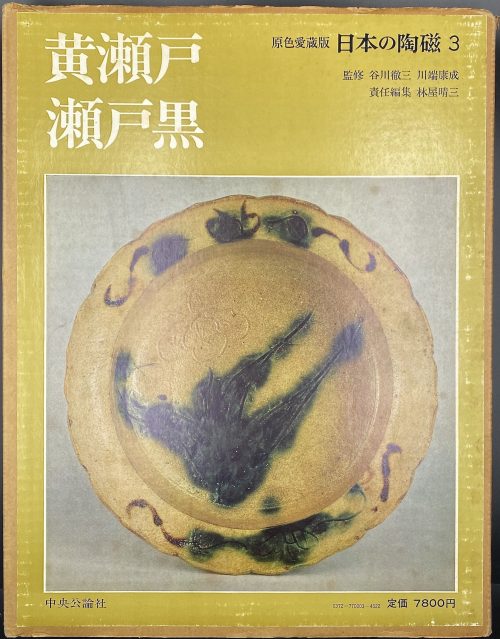 Hardcover volume, 35.3 x 27 cm, bound in grey cloth, blind stamped characters to front, brown characters to spine, in a glassine dust jacket, in a double slipcase, the outer case pictorial paper over cardboard, 36 x 28 cm, pp.: [4] [1] 2-88 (plates with photographs of 129 items), [2] 91-108 [3]. Seto ware [瀬戸焼] (Seto-yaki) – ceramics produced in and around the city of Seto in Aichi Prefecture. Yellow seto [黄瀬戸] (Kiseto) – a yellow glaze seto ware. Black seto [瀬戸黒] (Setoguro) – a black glaze seto ware. 日本の陶磁 – Japanese ceramics, series title. Contributors: Yasunari Kawabata [川端 康成] (Japanese, 1924 – 1972) – author. Tetsuzo Tanikawa [谷川 徹三] (Japanese, 1895 – 1989) – author. Seizo Hayashiya [林屋晴三] (Japanese, 1928 – 2017) – editor. Chūōkōron-sha [中央公論社] – publisher.
Hardcover volume, 35.3 x 27 cm, bound in grey cloth, blind stamped characters to front, brown characters to spine, in a glassine dust jacket, in a double slipcase, the outer case pictorial paper over cardboard, 36 x 28 cm, pp.: [4] [1] 2-88 (plates with photographs of 129 items), [2] 91-108 [3]. Seto ware [瀬戸焼] (Seto-yaki) – ceramics produced in and around the city of Seto in Aichi Prefecture. Yellow seto [黄瀬戸] (Kiseto) – a yellow glaze seto ware. Black seto [瀬戸黒] (Setoguro) – a black glaze seto ware. 日本の陶磁 – Japanese ceramics, series title. Contributors: Yasunari Kawabata [川端 康成] (Japanese, 1924 – 1972) – author. Tetsuzo Tanikawa [谷川 徹三] (Japanese, 1895 – 1989) – author. Seizo Hayashiya [林屋晴三] (Japanese, 1928 – 2017) – editor. Chūōkōron-sha [中央公論社] – publisher. -

Circular tsuba (marugata ) with design of futatsu-domoe (twofold tomoe) in negative openwork (kage-sukashi), folded-over rim (uchikaeshi-mimi ). The ‘head’ of the left tomoe altered to form an opening for scabbard accessory (kata-hitsu-ana), adorned with gold ategane fitting with file marks (tate-yasurime). The hammer-blow finish of the surface (tsuchime-ji). Signed to the left of nakaga-ana: Yamakichibei (山吉兵). Attributed by Steve Waszak a the Second Generation (Nidai) master.
NBTHK paper [translated by Markus Sesko]:Tomoe-sukashi-tsuba (巴透し鐔).
KANTEI-SHO (鑑定書) - APPRAISAL No 451718
Futatsu-domoe sukashi-tsuba (二巴透鐔) ‒ Tsuba with two tomoe comma openwork design
Signed: Yamakichibei (山吉兵)
Round shape (marugata ), iron, hammerblow finish (tsuchime-ji ), negative openwork design (kage-sukashi ), folded-over rim (uchikaeshi-mimi ), one opening for scabbard accessory
(kata-hitsu-ana) (with gold ategane fitting)
According to the result of the shinsa committee of our society, we judge this work as authentic
and rank it as Hozon Tōsōgu.
February 20, 2007
[Foundation] Nihon Bijutsu Tōken Hozon Kyōkai, NBTHK (日本美術刀劍保存協會)
Diameter: 76 mm, thickness at center 3.9 mm, thickness at rim: 5.1 mm; weight: 102.5 g
Tomoe (Comma): The character 巴 (Chinese pronunciation bā). A pattern resembling the two-comma tomoe (futatsu-domoe) has been found in ancient cultures on all inhabited continents. ...aside from their military function, a ritual or fetish value, perhaps related to their testicular shape. It also has yin-yang connotation. The gold sekigane confirms the high value of the piece to the owner.
-

Oblong round shape (nagamaru-gata) tsuba with design of dragonfly (tombo or katsumushi) and wheel (kuruma) in negative openwork (kage-sukashi), round rim (maru-mimi ). Copper sekigane.
Okamoto Yasukazu's Owari to Mikawa no tankō, №181 characterizes the tsuba as follows: "Katsumushi, kuruma-sukashi no zu (dragonfly and wheel sukashi). Mei: Yamakichibei (Shodai). Such small tsuba are rare for the Shodai. The nakago-ana is also small so it was probably intended to be mounted on a tantō. Regardless of its size, the iron is outstanding and the workmanship shows the characteristic features of the Shodai (first generation). The kuruma-sukashi design is interpreted here in a half-moon shape and only on one side of the tsuba. Such a design is also seen on works of the Nidai (second generation)...". Signed to the left of nakaga-ana: Yamakichibei (山吉兵へ). Attributed to the First Generation (Shodai) master.
NBTHK paper (translated by Markus Sesko): The Tokubetsu-Kichō Kodōgu. Kachimushi-kuruma sukashi-tsuba (勝虫車透鐔) - Tsuba with sukashi motif of dragonfly and cartwheel. Signed: Yamakichibei (山吉兵). Iron, marugata, ko-sukashi. Issued on April 1, 1977. [Copy only] Dimensions: H: 66 mm; W: 63.2 mm; Th(center): 3.8 mm; Th(rim): 3.5 mm. Weight: 68 g. -

A yamagane tsuba of oval form with green-ish black patina decorated in usuniku-bori carving and gold iroe with wisteria (fuji) motif plus nanako-ji ground on both sides. Kozuka-hitsu-ana possibly cut later.
Unsigned.
Momoyama or may be even Muromachi period. Dimensions: 70.0 x 61.2 x 5.0 (center) mm -

Yamagane (bronze) tsuba (kagamishi, or mirror-maker) with the design of tomoe (comma) and suhama in openwork. Surface treated with hammer marks and chiselled with the design of maple leaves and encircled two bars (maru-ni-futatsu-biki, Ashikaga clan family crest, or mon) on both sides. Raised rim or rim cover (fukurin). Custom kiri-wood box.
Size: 87.4 x 86.2 x 2.9 (center), 4.9 (rim) mm; weight: 120 g. -
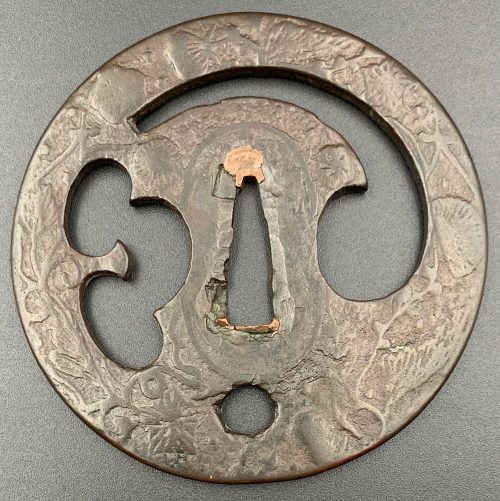
Yamagane (bronze) tsuba (kagami-shi, or mirror-maker) with the design of a star (round opening), tomoe (comma), and suhama in openwork. Surface cast and chiselled with the design of foliage, vines, blossoms, pine needles, and fruits on both sides.
The end of Early Muromachi period (1393-1453), circa 1450. Size: 83.7 x 84.1 x 3.6 (center), 4.1 (rim) mm; weight: 135.5 g. KANTEI-SHO (鑑定書) - APPRAISAL [translated by Markus Sesko]. No 463341 Tomoe-suhama-sukashi hana-karakusa no zu tsuba (巴洲浜透花唐草図鐔) ‒ Tsuba with stylized comma and bay inlet openwork and a flower and arabesque décor Unsigned: Kagami-shi (鏡師) Round shape, yamagane, hammer blow finish, cast, negative openwork design, round rim. According to the result of the shinsa committee of our society, we judge this work as authentic and rank it as Hozon Tōsōgu. July 1, 2011 [Foundation] Nihon Bijutsu Tōken Hozon Kyōkai, NBTHK (日本美術刀劍保存協會) -
 Iron tsuba of round form with design of wheel (kuruma) in openwork (sukashi). Squared rim. Copper sekigane. Yagyu school. Signed of the face: Fukui Tsuguzaemon. Early Edo period: Late 17th century (Kanbun/Enppo era). Height: 76.7 mm. Width: 76.8 mm. Rim thickness: 5.2 mm. Center thickness: 5.6 mm. Provenance: Sasano Masayuki Collection, № 203: "This design of spoke wheel relates to the 'circular principle' found in the Yagyu philosophy. Although it is very faint, Fukui Tsuguzaemon's signature is visible. Without a signature and based on appearance alone, it would undoubtable attributed to a later period".
Iron tsuba of round form with design of wheel (kuruma) in openwork (sukashi). Squared rim. Copper sekigane. Yagyu school. Signed of the face: Fukui Tsuguzaemon. Early Edo period: Late 17th century (Kanbun/Enppo era). Height: 76.7 mm. Width: 76.8 mm. Rim thickness: 5.2 mm. Center thickness: 5.6 mm. Provenance: Sasano Masayuki Collection, № 203: "This design of spoke wheel relates to the 'circular principle' found in the Yagyu philosophy. Although it is very faint, Fukui Tsuguzaemon's signature is visible. Without a signature and based on appearance alone, it would undoubtable attributed to a later period".Merrily Baird in her book "Symbols of Japan" [Merrily Baird. Symbols of Japan. Thematic motifs in art and design. Rizzoli international publications, Inc., 2001] provides the following explanation of the Wheel-of-the-Law symbol: "The Wheel-of-the-Law or Golden Wheel (rimbo, kinrin) has its origins in India, where it is known as chakra. [...] In Buddhist practice, it has been represented with eight spokes, reflecting the eight-fold path to overcoming worldly desire, and it signifies that all illusions will be crushed by the faith's enlightenment. [...] The Wheel-of-the-Law is an attribute of such deities as Senju Kannon, the Thousand-Armed Kannon, and Dainichi Nyorai, the all-illuminating solar figure who is the principal deity for Shingon Buddhism. From the Edo period on, the wheel also has been used in a secular manner", e.g. on family crests.
-
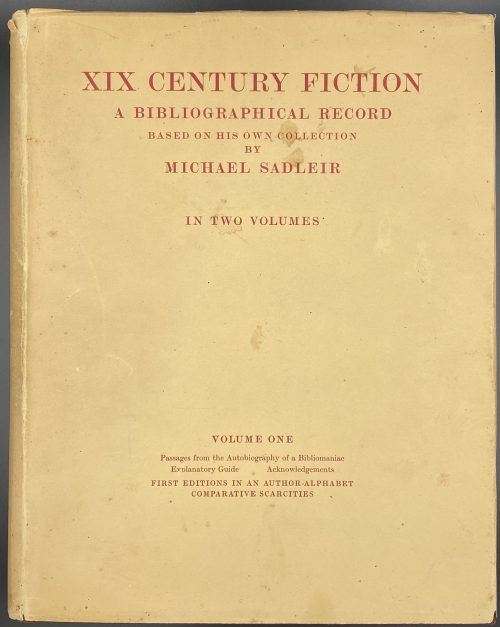 Title vol. 1: XIX CENTURY FICTION | A BIBLIOGRAPHICAL RECORD | BASED ON HIS OWN COLLECTION | BY | MICHAEL SADLEIR | IN TWO VOLUMES | VOLUME I | PRINTED AT THE UNIVERSITY PRESS, CAMBRIDGE | AND PUBLISHED | in Great Britain by | / CONSTABLE & CO LTD | 10–12 ORANGE STREET | LONDON W.C.2 / in the U.S.A. by the | CALIFORNIA UNIVERSITY | PRESS | LOS ANGELES, CAL.|| DJ vol. 1: XIX CENTURY FICTION | A BIBLIOGRAPHICAL RECORD | BASED ON HIS OWN COLLECTION | BY | MICHAEL SADLEIR | IN TWO VOLUMES | VOLUME ONE | Passages from the Autobiography of a Bibliomaniac | Explanatory Guide – Acknowledgements | FIRST EDITIONS IN AN AUTHOR-ALPHABET | COMPARATIVE SCARCITIES || Pagination: [4 blanks] ix-xxxiii, [2] 3-398 [399] [2 blanks] Collation: 4to; π2 [a]-d4 [1]-504. Title vol. 2: XIX CENTURY FICTION | A BIBLIOGRAPHICAL RECORD | BASED ON HIS OWN COLLECTION | BY | MICHAEL SADLEIR | IN TWO VOLUMES | VOLUME II | PRINTED AT THE UNIVERSITY PRESS, CAMBRIDGE | AND PUBLISHED | in Great Britain by | / CONSTABLE & CO LTD | 10–12 ORANGE STREET | LONDON W.C.2 / in the U.S.A. by the | CALIFORNIA UNIVERSITY | PRESS | LOS ANGELES, CAL.|| DJ vol. 2: XIX CENTURY FICTION | A BIBLIOGRAPHICAL RECORD | BASED ON HIS OWN COLLECTION | BY | MICHAEL SADLEIR | IN TWO VOLUMES | VOLUME TWO | “YELLOW-BACK” COLLECTION | FICTION SERIES || Pagination: [2 blanks] [8] [2] 3-195 [196 blank] [2 blanks]. Collation: 4to; π4 1-234 246. Binding: burgundy cloth, gilt vertical lettering to spine, Verity Hewitt (Canberra, AU) bookshop sticker to front pastedown; laid paper; cream DJ with lettering to front and spine. Edition: First limited edition of 1025 of which 1000 for sale. Unnumbered.
Title vol. 1: XIX CENTURY FICTION | A BIBLIOGRAPHICAL RECORD | BASED ON HIS OWN COLLECTION | BY | MICHAEL SADLEIR | IN TWO VOLUMES | VOLUME I | PRINTED AT THE UNIVERSITY PRESS, CAMBRIDGE | AND PUBLISHED | in Great Britain by | / CONSTABLE & CO LTD | 10–12 ORANGE STREET | LONDON W.C.2 / in the U.S.A. by the | CALIFORNIA UNIVERSITY | PRESS | LOS ANGELES, CAL.|| DJ vol. 1: XIX CENTURY FICTION | A BIBLIOGRAPHICAL RECORD | BASED ON HIS OWN COLLECTION | BY | MICHAEL SADLEIR | IN TWO VOLUMES | VOLUME ONE | Passages from the Autobiography of a Bibliomaniac | Explanatory Guide – Acknowledgements | FIRST EDITIONS IN AN AUTHOR-ALPHABET | COMPARATIVE SCARCITIES || Pagination: [4 blanks] ix-xxxiii, [2] 3-398 [399] [2 blanks] Collation: 4to; π2 [a]-d4 [1]-504. Title vol. 2: XIX CENTURY FICTION | A BIBLIOGRAPHICAL RECORD | BASED ON HIS OWN COLLECTION | BY | MICHAEL SADLEIR | IN TWO VOLUMES | VOLUME II | PRINTED AT THE UNIVERSITY PRESS, CAMBRIDGE | AND PUBLISHED | in Great Britain by | / CONSTABLE & CO LTD | 10–12 ORANGE STREET | LONDON W.C.2 / in the U.S.A. by the | CALIFORNIA UNIVERSITY | PRESS | LOS ANGELES, CAL.|| DJ vol. 2: XIX CENTURY FICTION | A BIBLIOGRAPHICAL RECORD | BASED ON HIS OWN COLLECTION | BY | MICHAEL SADLEIR | IN TWO VOLUMES | VOLUME TWO | “YELLOW-BACK” COLLECTION | FICTION SERIES || Pagination: [2 blanks] [8] [2] 3-195 [196 blank] [2 blanks]. Collation: 4to; π4 1-234 246. Binding: burgundy cloth, gilt vertical lettering to spine, Verity Hewitt (Canberra, AU) bookshop sticker to front pastedown; laid paper; cream DJ with lettering to front and spine. Edition: First limited edition of 1025 of which 1000 for sale. Unnumbered. -
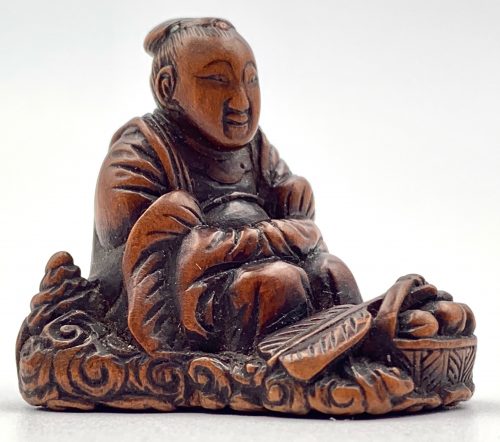 Wood netsuke of Seiōbo with a basket of immortal peaches, seated on a bed of clouds. Carver's signature tablet lost. Circa 1850. Dimensions: 32.6 x 28.1 x 20.1 mm.
Wood netsuke of Seiōbo with a basket of immortal peaches, seated on a bed of clouds. Carver's signature tablet lost. Circa 1850. Dimensions: 32.6 x 28.1 x 20.1 mm.Queen Mother of the West is a calque of Xiwangmu in Chinese sources, Seiōbo in Japan. Peaches of Immortality (Chinese: 仙桃) are consumed by the immortals due to their mystic virtue of conferring longevity on all who eat them.
Provenance: Charles Ephrussi (1849-1905) acquired in the 1870s; a wedding gift in 1898 to his cousin Ritter Viktor von Ephrussi (1860-1945) and Baroness Emilie (Emmy) Schey von Koromla (1879-1938); retrieved post-war by their daughter Elizabeth de Waal (1899-1991); given by her to her brother Ignaz (Iggie) Ephrussi (1906-1994), Tokyo; bequeathed by him to his great-nephew Edmund de Waal (born 1964), London, author of “The Hare with Amber Eyes: a hidden inheritance”. London / New York: Chatto & Windus / Farrar, Straus & Giroux. ISBN 978-0099539551. https://en.wikipedia.org/wiki/Charles_Ephrussi. https://en.wikipedia.org/wiki/Ephrussi_family. https://en.wikipedia.org/wiki/Edmund_de_Waal. -
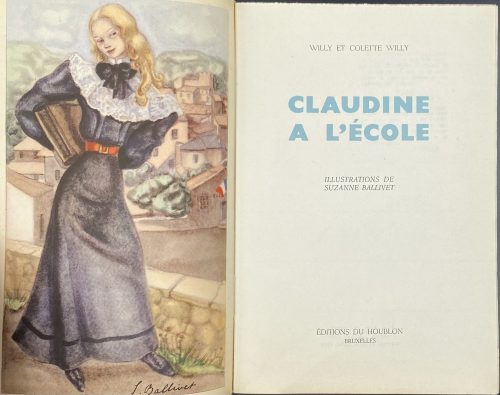 Title-page (turquoise and black): WILLY ET COLETTE WILLY | CLAUDINE | A L'ECOLE | ILLUSTRATIONS DE SUZANNE BALLIVET | ÉDITIONS DU HOUBLON | BRUXELLES || Front wrapper: WILLY ET COLETTE WILLY | {vignette} | ILLUSTRATIONS DE SUZANNE | CLAUDINE | A L'ÉCOLE || Description: French flapped wrappers, 21 x 14.5 cm, lettered front wrapper and spine, in glassine dustcover, paginated [1-8] 9-242 [6], 248 pages total, plus 8 photomechanical reproductions in colour after Suzanne Ballivet. Contributors: Sidonie-Gabrielle Colette [a.k.a. Colette] (French, 1873 – 1954) – author. Henry Gauthier-Villars [a.k.a. Willy] (French, 1859 – 1931) – author. Suzanne Ballivet (French, 1904 – 1985) – artist.
Title-page (turquoise and black): WILLY ET COLETTE WILLY | CLAUDINE | A L'ECOLE | ILLUSTRATIONS DE SUZANNE BALLIVET | ÉDITIONS DU HOUBLON | BRUXELLES || Front wrapper: WILLY ET COLETTE WILLY | {vignette} | ILLUSTRATIONS DE SUZANNE | CLAUDINE | A L'ÉCOLE || Description: French flapped wrappers, 21 x 14.5 cm, lettered front wrapper and spine, in glassine dustcover, paginated [1-8] 9-242 [6], 248 pages total, plus 8 photomechanical reproductions in colour after Suzanne Ballivet. Contributors: Sidonie-Gabrielle Colette [a.k.a. Colette] (French, 1873 – 1954) – author. Henry Gauthier-Villars [a.k.a. Willy] (French, 1859 – 1931) – author. Suzanne Ballivet (French, 1904 – 1985) – artist. -
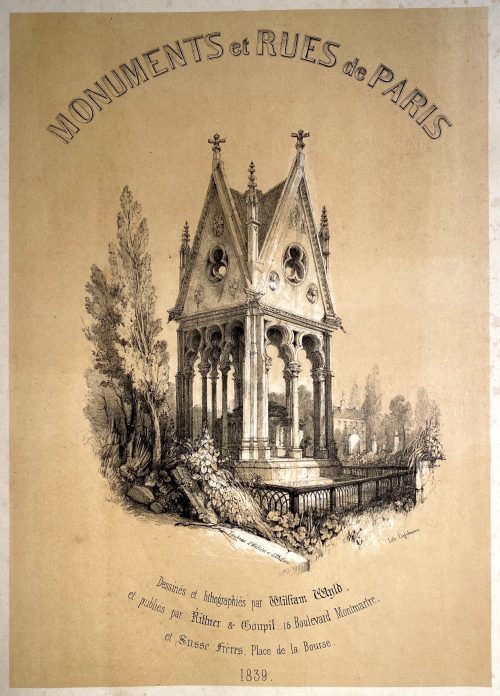 Pictorial album 55.5 x 41.0 cm, publisher’s quarter sheepskin over cloth, upper cover and flat spine lettered in gilt. Title: MONUMENTS et RUES de PARIS | Dessinés et lithographiés par William Wyld, | et publiés par Rittner & Goupil, 15 Boulevard Montmartre, | et Susse Frères, Place de la Bourse. | 1839. Collation: Title plate + 20 plates numbered from 1 to 20, printed by Godefroy Engelmann (French, 1788 – 1839) in tone lithography after drawings by William Wyld (British, 1806 – 1889). Published in Paris by Rittner & Goupil and Susse Frères in 1839. Plates: 54.8 x 39.8 cm. Contents:
Pictorial album 55.5 x 41.0 cm, publisher’s quarter sheepskin over cloth, upper cover and flat spine lettered in gilt. Title: MONUMENTS et RUES de PARIS | Dessinés et lithographiés par William Wyld, | et publiés par Rittner & Goupil, 15 Boulevard Montmartre, | et Susse Frères, Place de la Bourse. | 1839. Collation: Title plate + 20 plates numbered from 1 to 20, printed by Godefroy Engelmann (French, 1788 – 1839) in tone lithography after drawings by William Wyld (British, 1806 – 1889). Published in Paris by Rittner & Goupil and Susse Frères in 1839. Plates: 54.8 x 39.8 cm. Contents:Title page: Tombeau d'Heloïse et d'Abélard
- Le Pont Neuf
- L'église de la Madeleine
- La Porte St. Martin
- Palais des Tuileries
- Pont des Saints-Pères
- Hôtel de Ville
- Marché des Innocents
- Palais Royal
- Boulevard des Italiens
- Rue de la Paix
- Bourse et Tribunal de Commerce
- Porte St. Denis
- Pont Royal
- Place de la Concorde
- Paris from Père Lachaise
- Notre-Dame
- Jardin des Tuileries with Arc de Triomphe in the Distance
- Panthéon
- Chambre des députés
- Arc de Triomphe de l'Étoile


